Pioneer VSX-324-K-P User Manual
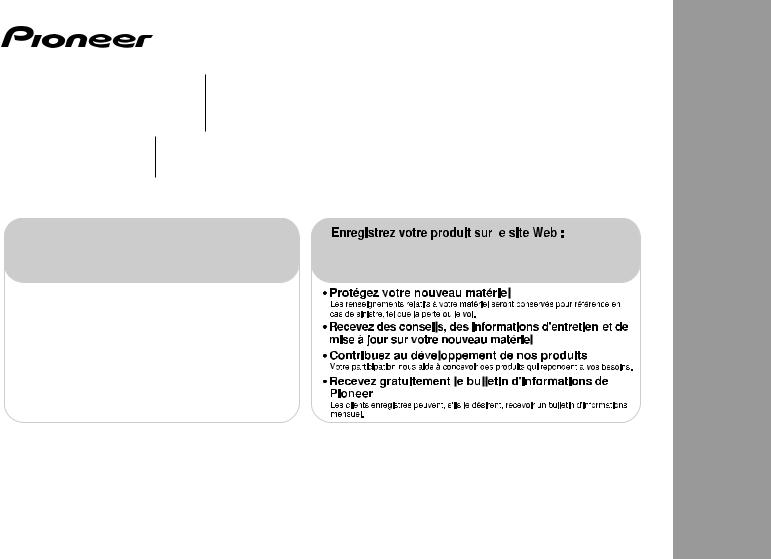
Home Theater Package
HTP-072 Ensemble de Cinéma Maison
Paquete de Home Theater
AV Receiver
VSX-324-K-P Récepteur AV
Receptor AV
Register your product on |
|
|
http://www.pioneerelectronics.com (US) |
http://www.pioneerelectronics.com (États-unis) |
|
http://www.pioneerelectronics.ca (Canada) |
http://www.pioneerelectronics.ca (Canada) |
|
• Protect your new investment
The details of your purchase will be on file for reference in the event of an insurance claim such as loss or theft.
• Receive free tips, updates and service bulletins on your new product
• Improve product development
Your input helps us continue to design products that meet your needs.
• Receive a free Pioneer newsletter
Registered customers can opt in to receive a monthly newsletter.
Operating Instructions Mode d’emploi
Manual de instrucciones

IMPORTANT
CAUTION
RISK OF ELECTRIC SHOCK
DO NOT OPEN
The lightning flash with arrowhead symbol, |
CAUTION: |
The exclamation point within an equilateral |
within an equilateral triangle, is intended to |
TO PREVENT THE RISK OF ELECTRIC |
triangle is intended to alert the user to the |
alert the user to the presence of uninsulated |
SHOCK, DO NOT REMOVE COVER (OR |
presence of important operating and |
“dangerous voltage” within the product’s |
BACK). NO USER-SERVICEABLE PARTS |
maintenance (servicing) instructions in the |
enclosure that may be of sufficient |
INSIDE. REFER SERVICING TO QUALIFIED |
literature accompanying the appliance. |
magnitude to constitute a risk of electric |
SERVICE PERSONNEL. |
|
shock to persons. |
|
|
|
|
D3-4-2-1-1b_A1_En |
NOTE:
This equipment has been tested and found to comply with the limits for a Class B digital device, pursuant to Part 15 of the FCC Rules. These limits are designed to provide reasonable protection against harmful interference in a residential installation. This equipment generates, uses, and can radiate radio frequency energy and, if not installed and used in accordance with the instructions, may cause harmful interference to radio communications. However, there is no guarantee that interference will not occur in a particular installation. If this equipment does cause harmful interference to radio or television reception, which can be determined by turning the equipment off and on, the user is encouraged to try to correct the interference by one or more of the following measures:
—Reorient or relocate the receiving antenna.
—Increase the separation between the equipment and receiver.
—Connect the equipment into an outlet on a circuit different from that to which the receiver is connected.
—Consult the dealer or an experienced radio/TV technician for help.
D8-10-1-2_A1_En
Information to User
Alterations or modifications carried out without appropriate authorization may invalidate the user’s right to operate the equipment.
D8-10-2_A1_En
WARNING
This equipment is not waterproof. To prevent a fire or shock hazard, do not place any container filled with liquid near this equipment (such as a vase or flower pot) or expose it to dripping, splashing, rain or moisture.
D3-4-2-1-3_A1_En
WARNING
To prevent a fire hazard, do not place any naked flame sources (such as a lighted candle) on the equipment.
D3-4-2-1-7a_A1_En
2
VENTILATION CAUTION
When installing this unit, make sure to leave space around the unit for ventilation to improve heat radiation (at least 20 cm at top, 10 cm at rear, and 10 cm at each side).
WARNING
Slots and openings in the cabinet are provided for ventilation to ensure reliable operation of the product, and to protect it from overheating. To prevent fire hazard, the openings should never be blocked or covered with items (such as newspapers, table-cloths, curtains) or by operating the equipment on thick carpet or a bed.
D3-4-2-1-7b*_A1_En
Operating Environment
Operating environment temperature and humidity: +5 °C to +35 °C (+41 °F to +95 °F); less than 85 %RH (cooling vents not blocked)
Do not install this unit in a poorly ventilated area, or in locations exposed to high humidity or direct sunlight (or strong artificial light)
D3-4-2-1-7c*_A1_En
Caution
To prevent fire hazard, the Class 2 Wiring Cable should be used for connection with speaker, and should be routed away from hazards to avoid damage to the insulation of the cable.
D3-7-13-67*_A1_En
En
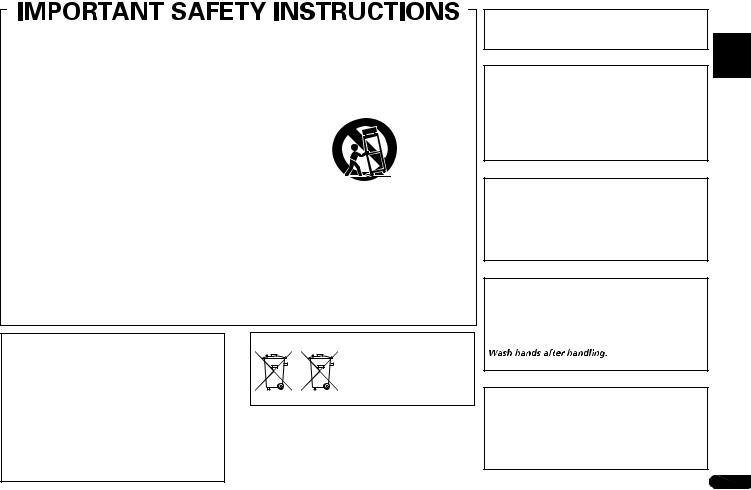
1)Read these instructions.
2)Keep these instructions.
3)Heed all warnings.
4)Follow all instructions.
5)Do not use this apparatus near water.
6)Clean only with dry cloth.
7)Do not block any ventilation openings. Install in accordance with the manufacturer’s instructions.
8)Do not install near any heat sources such as radiators, heat registers, stoves, or other apparatus (including amplifiers) that produce heat.
9)Do not defeat the safety purpose of the polarized or grounding-type plug. A polarized plug has two blades with one wider than the other. A grounding type plug has two blades and a third grounding prong. The wide blade or the third prong are provided for your safety. If the provided plug does not fit into your outlet, consult an electrician for replacement of the obsolete outlet.
10)Protect the power cord from being walked on or pinched particularly at plugs, convenience receptacles, and the point where they exit from the apparatus.
11)Only use attachments/accessories specified by the manufacturer.
12)Use only with the cart, stand, tripod, bracket, or table specified by the manufacturer, or sold with the apparatus. When a cart is used, use caution when moving the cart/apparatus combination to avoid injury from tip-over.
13)Unplug this apparatus during lightning storms or when unused for long periods of time.
14)Refer all servicing to qualified service personnel. Servicing is required when the apparatus has been damaged in any way, such as power-supply cord or plug is damaged, liquid has been spilled or objects have fallen into the apparatus, the apparatus has been exposed to rain or moisture, does not operate normally, or has been dropped.
D3-7-13-69_En
CAUTION
The STANDBY/ON switch on this unit will not completely shut off all power from the AC outlet. Since the power cord serves as the main disconnect device for the unit, you will need to unplug it from the AC outlet to shut down all power. Therefore, make sure the unit has been installed so that the power cord can be easily unplugged from the AC outlet in case of an accident. To avoid fire hazard, the power cord should also be unplugged from the AC outlet when left unused for a long period of time (for example, when on vacation).
STANDBY/ON switch on this unit will not completely shut off all power from the AC outlet. Since the power cord serves as the main disconnect device for the unit, you will need to unplug it from the AC outlet to shut down all power. Therefore, make sure the unit has been installed so that the power cord can be easily unplugged from the AC outlet in case of an accident. To avoid fire hazard, the power cord should also be unplugged from the AC outlet when left unused for a long period of time (for example, when on vacation).
D3-4-2-2-2a*_A1_En
(Symbol examples for batteries)
These symbols are only valid in the European Union.
Pb |
K058c_A1_En |
WARNING
Store small parts out of the reach of children and infants. If accidentally swallowed, contact a doctor immediately.
D41-6-4_A1_En
This Class B digital apparatus complies with Canadian ICES-003.
D8-10-1-3_A1_En
CAUTION
This product satisfies FCC regulations when shielded cables and connectors are used to connect the unit to other equipment. To prevent electromagnetic interference with electric appliances such as radios and televisions, use shielded cables and connectors for connections.
D8-10-3a_A1_En
IMPORTANT NOTICE
THE MODEL NUMBER AND SERIAL NUMBER OF THIS EQUIPMENT ARE ON THE REAR OR BOTTOM. RECORD THESE NUMBERS ON YOUR ENCLOSED WARRANTY CARD AND KEEP IN A SAFE PLACE FOR FUTURE REFERENCE.
D36-AP9-1_A1_En
WARNING: Handling the cord on this product or cords associated with accessories sold with the product may expose you to chemicals listed on proposition 65 known to the State of California and other governmental entities to cause cancer and birth defect or other reproductive harm.
D36-P5_B1_En
This product is for general household purposes. Any failure due to use for other than household purposes (such as long-term use for business purposes in a restaurant or use in a car or ship) and which requires repair will be charged for even during the warranty period.
K041_A1_En
Español Français English
3
En

Thank you for buying this Pioneer product. Please read through these operating instructions so you will know how to operate your model properly. After you have finished reading the instructions, put them away in a safe place for future reference.
Contents
Before you start . . . . . . . . . . . . . . . . . . . . . . . . . . . . 5
Checking what’s in the box . . . . . . . . . . . . . . . . . . . . . . . . 5 Installing the receiver . . . . . . . . . . . . . . . . . . . . . . . . . . . . 5
Flow of settings on the receiver. . . . . . . . . . . . . . 5
01 Controls and displays
Front panel . . . . . . . . . . . . . . . . . . . . . . . . . . . . . . . . . . . . 6 Display . . . . . . . . . . . . . . . . . . . . . . . . . . . . . . . . . . . . . . 7 Remote control . . . . . . . . . . . . . . . . . . . . . . . . . . . . . . . . . 8 Loading the batteries . . . . . . . . . . . . . . . . . . . . . . . . . . . 9
Operating range of remote control . . . . . . . . . . . . . . . . . 9
02 Connecting your equipment
Placing the speakers. . . . . . . . . . . . . . . . . . . . . . . . . . . . 10
Hints on the speaker placement. . . . . . . . . . . . . . . . . . 10
Connecting the speakers. . . . . . . . . . . . . . . . . . . . . . . . . 11 Making cable connections . . . . . . . . . . . . . . . . . . . . . . . 12 HDMI cables . . . . . . . . . . . . . . . . . . . . . . . . . . . . . . . . 12 About HDMI. . . . . . . . . . . . . . . . . . . . . . . . . . . . . . . . . 12 Analog audio cables. . . . . . . . . . . . . . . . . . . . . . . . . . . 13 Digital audio cables . . . . . . . . . . . . . . . . . . . . . . . . . . . 13 Standard RCA video cables . . . . . . . . . . . . . . . . . . . . . 13
About video outputs connection . . . . . . . . . . . . . . . . . . . 13 Connecting a TV and playback components . . . . . . . . . . 14
Connecting using HDMI . . . . . . . . . . . . . . . . . . . . . . . 14
Connecting your component with no HDMI terminal . . 15
Connecting antennas . . . . . . . . . . . . . . . . . . . . . . . . . . . 16 Using external antennas . . . . . . . . . . . . . . . . . . . . . . . 16 Connecting an iPod. . . . . . . . . . . . . . . . . . . . . . . . . . . . . 16 Connecting a USB device . . . . . . . . . . . . . . . . . . . . . . . . 17 Plugging in the receiver . . . . . . . . . . . . . . . . . . . . . . . . . 17
03 Basic playback
Playing a source . . . . . . . . . . . . . . . . . . . . . . . . . . . . . . . 18
Selecting the audio input signal . . . . . . . . . . . . . . . . . 18
Playing an iPod. . . . . . . . . . . . . . . . . . . . . . . . . . . . . . . . 19
Playing back files stored on an iPod . . . . . . . . . . . . . . 20
Basic playback controls. . . . . . . . . . . . . . . . . . . . . . . . 20
Switches between the iPod controls and the receiver controls . . . . . . . . . . . . . . . . . . . . . . . . . . . . . . . . . . . . 20
Playing a USB device . . . . . . . . . . . . . . . . . . . . . . . . . . . 20 Basic playback controls. . . . . . . . . . . . . . . . . . . . . . . . 21
Compressed audio compatibility . . . . . . . . . . . . . . . . . 21
Listening to the radio . . . . . . . . . . . . . . . . . . . . . . . . . . . 21 Improving FM sound . . . . . . . . . . . . . . . . . . . . . . . . . . 21 Saving station presets . . . . . . . . . . . . . . . . . . . . . . . . . 22
Listening to station presets . . . . . . . . . . . . . . . . . . . . . 22
Naming preset stations . . . . . . . . . . . . . . . . . . . . . . . . 22
04 Listening to your system
Choosing the listening mode . . . . . . . . . . . . . . . . . . . . . 23
Auto playback . . . . . . . . . . . . . . . . . . . . . . . . . . . . . . . 23
Listening in surround sound . . . . . . . . . . . . . . . . . . . . 23 Using the Advanced surround . . . . . . . . . . . . . . . . . . 23
Using Stream Direct . . . . . . . . . . . . . . . . . . . . . . . . . . 24 Using the Sound Retriever . . . . . . . . . . . . . . . . . . . . . . . 24
Better sound using Phase Control . . . . . . . . . . . . . . . . . 24
Setting the Audio options . . . . . . . . . . . . . . . . . . . . . . . . 25
05 Home menu
Using the Home menu . . . . . . . . . . . . . . . . . . . . . . . . . . 27 Manual speaker setup . . . . . . . . . . . . . . . . . . . . . . . . . . 27 Speaker Setting . . . . . . . . . . . . . . . . . . . . . . . . . . . . . . 27 X.Over . . . . . . . . . . . . . . . . . . . . . . . . . . . . . . . . . . . . . 28 Channel Level . . . . . . . . . . . . . . . . . . . . . . . . . . . . . . . 28 Speaker Distance . . . . . . . . . . . . . . . . . . . . . . . . . . . . 29 The Input Assign menu. . . . . . . . . . . . . . . . . . . . . . . . . . 29 The Auto Power Down menu . . . . . . . . . . . . . . . . . . . . . 29 The HDMI Setup menu . . . . . . . . . . . . . . . . . . . . . . . . . . 30
06 Additional information
Troubleshooting . . . . . . . . . . . . . . . . . . . . . . . . . . . . . . . 31 General . . . . . . . . . . . . . . . . . . . . . . . . . . . . . . . . . . . . 31 HDMI . . . . . . . . . . . . . . . . . . . . . . . . . . . . . . . . . . . . . 32
Important information regarding the HDMI
connection . . . . . . . . . . . . . . . . . . . . . . . . . . . . . . . . . 32 iPod messages . . . . . . . . . . . . . . . . . . . . . . . . . . . . . . 32 USB messages . . . . . . . . . . . . . . . . . . . . . . . . . . . . . . 32 About iPod/iPhone. . . . . . . . . . . . . . . . . . . . . . . . . . . . . 33 Resetting the main unit . . . . . . . . . . . . . . . . . . . . . . . . . 33 Cleaning the unit . . . . . . . . . . . . . . . . . . . . . . . . . . . . . . 33 Specifications . . . . . . . . . . . . . . . . . . . . . . . . . . . . . . . . 33
4
En

Before you start
Checking what’s in the box
Please check that you’ve received the following supplied accessories:
•Remote control
•AAA size IEC R03 dry cell batteries (to confirm system operation) x2
•AM loop antenna
•FM wire antenna
•SPEAKER CAUTION Sheet (English only)
•These operating instructions
Installing the receiver
•When installing this unit, make sure to put it on a level and stable surface.
Don’t install it on the following places:
–on a color TV (the screen may distort)
–near a cassette deck (or close to a device that gives off a magnetic field). This may interfere with the sound.
–in direct sunlight
–in damp or wet areas
–in extremely hot or cold areas
–in places where there is vibration or other movement
–in places that are very dusty
–in places that have hot fumes or oils (such as a kitchen)
Flow of settings on the receiver
The unit is a full-fledged AV receiver equipped with an abundance of functions and terminals. It can be used easily after following the procedure below to make the connections and settings.
The colors of the steps indicate the following:
Required setting item
Setting to be made as necessary
1 Connecting the speakers
Where you place the speakers will have a big effect on the sound.
•Placing the speakers (page 10)
•Connecting the speakers (page 11)
2 Connecting the components
For surround sound, you’ll want to hook up using a digital connection from the Blu-ray Disc/DVD player to the receiver.
•About video outputs connection (page 13)
•Connecting a TV and playback components (page 14)
•Connecting antennas (page 16)
•Plugging in the receiver (page 17)
3 Power On
Make sure you’ve set the video input on your TV to this receiver. Check the manual that came with the TV if you don’t know how to do this.
4The Input Assign menu (page 29)
(When using connections other than the recommended connections.)
The HDMI Setup menu (page 30)
(When the connected TV supports the HDMI Audio Return Channel function.)
5Basic playback (page 18)
•Selecting the audio input signal (page 18)
•Playing an iPod (page 19)
•Playing a USB device (page 20)
•Choosing the listening mode (page 23)
6Adjusting the sound as desired
•Using the Sound Retriever (page 24)
•Better sound using Phase Control (page 24)
•Setting the Audio options (page 25)
•Manual speaker setup (page 27)
Español Français English
5
En
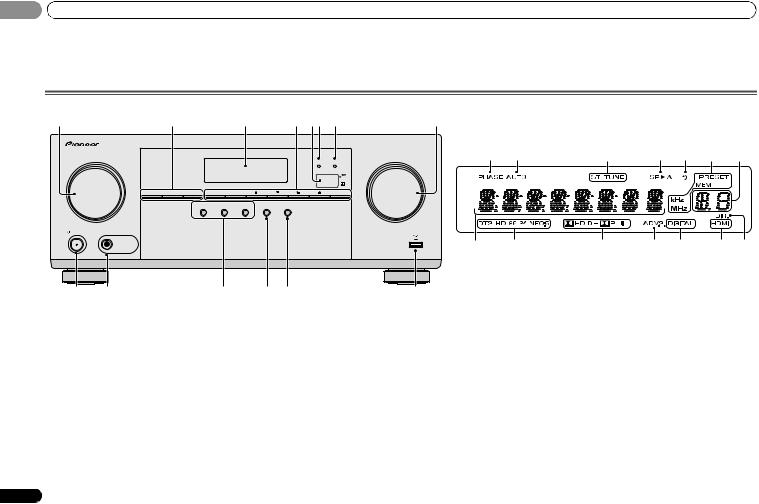
01 Controls and displays
Chapter 1:
Controls and displays
Front panel
1 |
2 |
3 |
4 |
5 6 |
7 |
8 |
AV RECEIVER VSX-324
15 16
HDMI |
iPod iPhone |
SPEAKERS |
DIMMER |
DISPLAY |
BAND |
TUNER EDIT |
TUNE |
PRESET |
ENTER |
AUTO SURROUND/ |
ALC/ |
ADVANCED |
|
iPod iPhone |
STREAM DIRECT |
STANDARD SURR |
SURROUND |
ECO |
DIRECT CONTROL |
INPUT |
|
|
|
|
|
MASTER |
|
SELECTOR |
|
|
|
|
|
VOLUME |
|
STANDBY/ON |
|
|
|
|
|
|
|
|
|
|
|
|
5V |
1A |
22 |
|
|
PHONES |
|
|
|
21 |
|
9 |
10 |
11 |
12 |
13 |
14 |
|
|
1 INPUT SELECTOR dial
Selects an input source (page 18).
2Receiver control buttons
SPEAKERS – Use to change the speaker system on or off. When the SP OFF is selected, no sound is output from the speakers connected to this receiver.
DIMMER – Dims or brightens the display. The brightness can be controlled in four steps.
DISPLAY – Switches the display of this unit. The listening mode, sound volume, input name can be checked by selecting an input source.
3Character display
See Display on page 7.
4Tuner control buttons
BAND – Switches between AM, FM ST (stereo) and FM MONO radio bands (page 21).
TUNER EDIT – Use with TUNE /, PRESET / and
ENTER to memorize and name stations for recall (page 21).
TUNE / – Used to find radio frequencies (page 21).
PRESET / – Use to select preset radio stations (page 22).
5 Remote sensor
Receives the signals from the remote control (see Operating range of remote control on page 9).
6 HDMI indicator
Blinks when connecting an HDMI-equipped component; lights when the component is connected (page 14).
7 iPod iPhone indicator
Lights when an iPod/iPhone is connected and iPod/USB input is selected (page 19).
6
17 18 19 17 20
23 |
24 |
25 |
25 |
26 |
8MASTER VOLUME dial
9STANDBY/ON
10PHONES jack
Use to connect headphones. When the headphones are connected, there is no sound output from the speakers. The listening mode when the sound is heard from the headphone can be selected only from PHONES SURR, STEREO or
STEREO ALC mode.
11Listening mode buttons
AUTO SURROUND/STREAM DIRECT – Switches between Auto surround mode (page 23) and Stream Direct playback (page 24).
ALC/STANDARD SURR – Press for standard decoding and to switch between the modes of 2Pro Logic and NEO:6, and the Auto level control stereo mode (page 23).
ADVANCED SURROUND – Switches between the various surround modes (page 23).
En

Controls and displays
12 ECO
Switches between ECO Mode 1/ECO Mode 2. When ECO Mode is turned ON, the display will go dark (page 23).
13 iPod iPhone DIRECT CONTROL
Change the receiver’s input to the iPod and enable iPod operations on the iPod (page 20).
14 iPod/iPhone terminal
Use to connect your Apple iPod or USB mass storage device as an audio source (page 16).
Display
15 PHASE
Lights when the Phase Control is switched on (page 24).
16 AUTO
Lights when the Auto Surround feature is switched on (page 23).
17Tuner indicators
ST – Lights when a stereo FM broadcast is being received in auto stereo mode (page 21).
TUNE – Lights when a normal broadcast channel.
PRESET – Shows when a preset radio station is registered or called.
MEM – Blinks when a radio station is registered.
kHz/MHz – Lights when the character display is showing the currently received AM/FM broadcast frequency.
18Speaker indicators
Shows if the speaker system is on or not (page 6). SP A means the speakers are switched on.
SP means the speakers are switched off.
19 Sleep timer indicator
Lights when the receiver is in sleep mode (page 8).
20PRESET information or input signal indicator
Shows the preset number of the tuner or the input signal type, etc.
21Character display
Displays various system information.
22DTS indicators
DTS – Lights when a source with DTS encoded audio signals is detected.
HD – Lights when a source with DTS-EXPRESS or DTSHD encoded audio signals is detected.
96/24 – Lights when a source with DTS 96/24 encoded audio signals is detected.
NEO:6 – When one of the NEO:6 modes of the receiver is on, this lights to indicate NEO:6 processing (page 23).
23Dolby Digital indicators
2D – Lights when a Dolby Digital encoded signal is detected.
2D+ – Lights when a source with Dolby Digital Plus encoded audio signals is detected.
2HD – Lights when a source with Dolby TrueHD encoded audio signals is detected.
2PLII – Lights to indicate 2Pro Logic II decoding (see
Listening in surround sound on page 23 for more on this).
24ADV.S.
Lights when one of the Advanced Surround modes has been selected (see Using the Advanced surround on page 23 for more on this).
25SIGNAL SELECT indicators
DIGITAL – Lights when a digital audio signal is selected. Blinks when a digital audio signal is selected and selected audio input is not provided.
HDMI – Lights when an HDMI signal is selected. Blinks when an HDMI signal is selected and selected HDMI input is not provided.
26DIR.
Lights when the DIRECT or PURE DIRECT mode is switched on (page 24).
0101
Español Français English
7
En

01 Controls and displays
Remote control
1 |
|
|
|
|
13 |
|
RECEIVER SLEEP |
SOURCE |
TV |
|
|
2 |
CONTROL |
|
|||
|
|
|
|
|
|
3 |
RECEIVER |
INPUT SELECT |
|
|
|
|
|
|
INPUT |
|
|
4 |
BD |
DVD |
CD |
|
14 |
|
TUNER |
iPod/USB SAT/CBL |
CH |
|
|
5 |
|
|
|||
|
|
|
|
|
|
|
GAME |
TV |
SIGNAL SEL |
|
|
6 |
Acous.EQ |
S.RETRIEVER |
PHASE |
VOL |
|
7 |
|
|
|
|
|
8 |
AUTO/ |
|
ALC/ |
|
|
DIRECT |
STEREO |
STANDARD |
ADV SURR |
|
|
|
|
|
ECO |
|
|
|
AUDIO |
|
TOOLS |
|
|
|
PARAMETER |
|
MENU |
VOLUME |
|
|
TOP |
TUNE |
|
|
|
9 |
MENU |
|
|
|
|
|
T |
|
P |
|
|
|
E |
|
R |
|
15 |
|
P |
|
E |
|
|
|
S |
ENTER |
E |
|
|
|
E |
S |
|
|
|
|
R |
|
T |
|
|
10 |
|
|
|
|
|
HOME |
|
|
|
|
|
|
|
|
|
|
|
|
MENU |
TUNE |
BAND |
|
|
|
PTY |
|
|
||
|
iPod CTRL |
|
RETURN |
|
|
|
|
|
|
MUTE |
16 |
11 |
|
|
|
|
|
BASS |
TRE |
|
|||
|
1 |
2 |
3 |
DISP |
17 |
|
|
SB CH |
CH SELECT |
|
|
12 |
4 |
5 |
6 |
CH |
|
MIDNIGHT SPEAKERS |
LEV |
|
|
||
|
7 |
8 |
9 |
CH |
|
|
|
0 |
LEV |
DIMMER |
|
|
CLR |
ENTER |
|
|
|
+10
RECEIVER
8
As for operating other devices, the remote control codes for the Pioneer products are preset. The settings cannot be changed.
1 SLEEP
Press to change the amount of time before the receiver switches into standby (30 min – 60 min – 90 min – Off). You can check the remaining sleep time at any time by pressing
SLEEP once.
2 RECEIVER
Switches the receiver between standby and on.
3 RECEIVER
Switches the remote to control the receiver (used to select the white commands above the number buttons (MIDNIGHT, etc)). Also use this button to set up surround sound (page 27) or Audio parameters (page 25).
4 INPUT SELECT 
Use to select the input source (page 18).
5 Input function buttons
Use to select the input source to this receiver (page 18). This will enable you to control other Pioneer components with the remote control.
6 SIGNAL SEL
Press to select the audio input signal of the component to play back (page 18).
7Sound control buttons
Acous.EQ – Cannot use for this unit.
S.RETRIEVER – Press to restore CD quality sound to compressed audio sources (page 24).
PHASE – Press to switch on/off Phase Control (page 24).
8Listening mode and component control buttons
AUTO/DIRECT – Switches between Auto surround mode (page 23) and Stream Direct playback (page 24). STEREO – Press to select stereo playback (page 23).
ALC/STANDARD – Press for standard decoding and to switch between the modes of 2Pro Logic II and NEO:6, and the Auto level control stereo mode (page 23).
ADV SURR – Switches between the various surround modes (page 23).
ECO – Switches between ECO Mode 1/ECO Mode 2. When ECO Mode is turned ON, the display will go dark (page 23).
9 Receiver and component control buttons
The following button controls can be accessed after you have selected the corresponding input function button (BD, DVD, etc.).
Press RECEIVER first to access:
AUDIO PARAMETER – Use to access the Audio options (page 25).
HOME MENU – Press to access the Home Menu (page 27).
RETURN – Confirm and exit the current menu screen. Press BD, DVD first to access:
TOP MENU – Displays the disc ‘top’ menu of a Blu-ray Disc/DVD.
HOME MENU – Displays the HOME MENU screen. RETURN – Confirm and exit the current menu screen. MENU – Displays the TOOLS menu of Blu-ray Disc player.
Press TUNER first to access:
TOOLS – Memorizes stations for recall, also used to change the name (page 22).
BAND – Switches between AM, FM ST (stereo) and FM MONO radio bands (page 21).
Press iPod/USB first to access:
iPod CTRL – Switches between the iPod controls and the receiver controls (page 20).
10 / / / (TUNE /, PRESET /), ENTER
Use the arrow buttons when setting up your surround sound system (page 27). Also used to control Blu-ray Disc/DVD menus/options.
Use TUNE / can be used to find radio frequencies and PRESET / can be used to select preset radio stations (page 22).
En

Controls and displays |
0101 |
11 Component control buttons
The main buttons ( , , etc.) are used to control a component after you have selected it using the input function buttons.
The controls above these buttons can be accessed after you have selected the corresponding input function button (BD, DVD and CD). These buttons also function as described below.
Press RECEIVER first to access:
BASS –/+, TRE –/+ – Use to adjust Bass or Treble.
•These controls are disabled when the listening mode is set to DIRECT or PURE DIRECT.
•When the front speaker is set at SMALL in the Speaker Setting and the X.over is set above 150 Hz, the subwoofer channel level will be adjusted by pressing BASS –/+ (page 28).
12 Number buttons and other component controls
Use the number buttons to directly select a radio frequency (page 21) or the tracks on a CD, etc. There are other buttons that can be accessed after RECEIVER is pressed. (For example MIDNIGHT, etc.)
SB CH– Cannot use for this unit.
CH SELECT – Press repeatedly to select a channel, then use LEV +/– to adjust the level (page 28).
LEV +/– – Use to adjust the channel level.
MIDNIGHT – Switches to Midnight or Loudness listening (page 25).
SPEAKERS – Use to change the speaker system on or off. When the SP OFF is selected, no sound is output from the speakers connected to this receiver.
DIMMER – Dims or brightens the display. The brightness can be controlled in four steps.
13 SOURCE
Turns on or off the power of the Pioneer DVD/DVR units when BD, DVD or CD is selected using the input function buttons.
14 TV CONTROL buttons
These buttons can control only be used with Pioneer TVs.– Use to turn on/off the power of the TV.
INPUT – Use to select the TV input signal. CH +/– – Use to select channels.
VOL +/– – Use to adjust the volume on your TV.
15 VOLUME +/–
Use to set the listening volume.
16 MUTE
Mutes/unmutes the sound.
17 DISP
Switches the display of this unit. The listening mode, sound volume or input name can be checked by selecting an input source.
Loading the batteries
The batteries included with the unit are to check initial operations; they may not last over a long period. We recommend using alkaline batteries that have a longer life.
 CAUTION
CAUTION
•Incorrect use of batteries may result in such hazards as leakage and bursting. Observe the following precautions: -Never use new and old batteries together.
-Insert the plus and minus sides of the batteries properly according to the marks in the battery case.
-Batteries with the same shape may have different voltages. Do not use different batteries together.
-When disposing of used batteries, please comply with governmental regulations or environmental public institution’s rules that apply in your country/area.
-When inserting the batteries, make sure not to damage the springs on the battery’s (–) terminals. This can cause batteries to leak or overheat.
WARNING
Do not use or store batteries in direct sunlight or other excessively hot place, such as inside a car or near a heater. This can cause batteries to leak, overheat, explode or catch fire. It can also reduce the life or performance of batteries.
Operating range of remote control
The remote control may not work properly if:
•There are obstacles between the remote control and the receiver’s remote sensor.
•Direct sunlight or fluorescent light is shining onto the remote sensor.
•The receiver is located near a device that is emitting infrared rays.
•The receiver is operated simultaneously with another infrared remote control unit.
30°  30°
30° 
7 m (23 ft.)
Español Français English
9
En
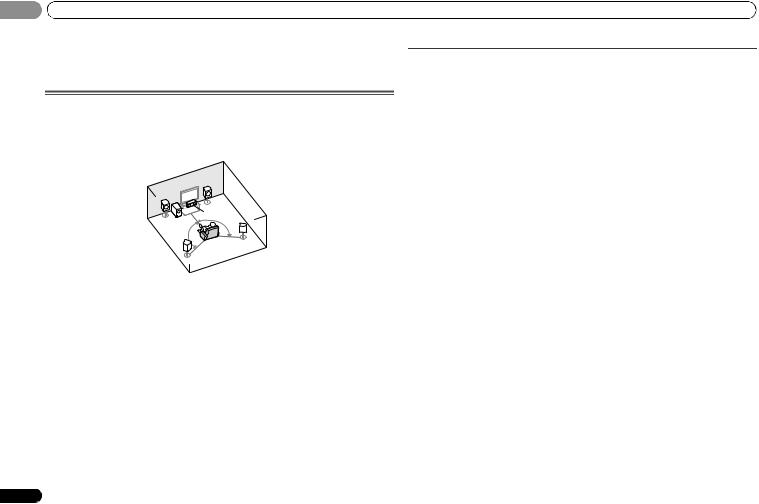
02 Connecting your equipment
Chapter 2:
Connecting your equipment
Placing the speakers
By connecting the left and right front speakers (L/R), the center speaker (C), the left and right surround speakers (SL/SR), and the subwoofer (SW), a 5.1 ch surround system can be enjoyed.
To achieve the best possible surround sound, install your speakers as shown below.
5.1 channel surround system:
R
L
 C
C
SW  120
120
120
SR
SL
10
Hints on the speaker placement
Where you put your speakers in the room has a big effect on the quality of the sound. The following guidelines should help you to get the best sound from your system.
•The subwoofer can be placed on the floor. Ideally, the other speakers should be at about ear-level when you’re listening to them. Putting the speakers on the floor (except the subwoofer), or mounting them very high on a wall is not recommended.
•Speakers installed to the right and left should be separated by about 1.8 m to 2.7 m (6 ft. to 8.9 ft.) distance. They should be installed at equal distances from the television, and at equal heights from the floor.
•If you’re going to place speakers around your CRT TV, place the speakers at a sufficient distance from your CRT TV.
•If you’re using a center speaker, place the front speakers at a wider angle. If not, place them at a narrower angle.
•Place the center speaker above or below the TV so that the sound of the center channel is localized at the TV screen. Also, make sure the center speaker does not cross the line formed by the leading edge of the front left and right speakers.
•It is best to angle the speakers towards the listening position. The angle depends on the size of the room. Use less of an angle for bigger rooms.
•Surround speakers should be positioned 60 cm to 90 cm (2 ft. to 3 ft.) higher than your ears and titled slight downward. Make sure the speakers don’t face each other. For DVD-Audio, the speakers should be more directly behind the listener than for home theater playback.
•Try not to place the surround speakers farther away from the listening position than the front and center speakers. Doing so can weaken the surround sound effect.
 CAUTION
CAUTION
•Make sure that all speakers are securely installed. This not only improves sound quality, but also reduces the risk of damage or injury resulting from speakers being knocked over or falling in the event of external shocks such as earthquakes.
En

Connecting your equipment
Connecting the speakers
The receiver will work with just two stereo speakers (the front speakers in the diagram) but using at least three speakers is recommended, and a complete setup is best for surround sound.
Make sure you connect the speaker on the right to the right (R) terminal and the speaker on the left to the left (L) terminal. Also make sure the positive and negative (+/–) terminals on the receiver match those on the speakers.
You can use speakers with a nominal impedance between 6 and 16 .
Be sure to complete all connections before connecting this unit to the AC power source.
Bare wire connections
1 |
Push open the tabs and insert exposed |
1 |
2 |
|
wire. |
||||
|
|
|||
2 |
Release the tabs. |
|
|
|
 CAUTION
CAUTION
•These speaker terminals carry HAZARDOUS LIVE voltage. To prevent the risk of electric shock when connecting or disconnecting the speaker cables, disconnect the power cord before touching any uninsulated parts.
•Make sure that all the bare speaker wire is inserted fully into the speaker terminal. If any of the bare speaker wire touches the back panel it may cause the power to cut off as a safety measure.
Front right Front left
Center Subwoofer
HDMI |
IN |
IN |
OUT |
|
|
|
DVD |
SAT/CBL |
GAME |
BD |
IN 1 |
IN 1 |
|
|
|
|
ASSIGNABLE |
(CD) |
(TV) |
ASSIGNABLE |
COAXIAL OPTICAL
ANTENNA |
VIDEO |
AUDIO |
SPEAKERS A |
AM LOOP |
R |
L |
FRONT |
CENTER |
|
|
|
R |
L |
|
|
|
DVD IN |
|
|
||
|
|
|
|
|
|
|
SAT/CBL |
|
|
|
|
|
IN |
|
|
|
|
|
ANALOG IN 1 |
|
|
|
|
FM UNBAL |
(CD) |
|
|
|
|
75

 ASSIGNABLE
ASSIGNABLE
MONITOR
OUT
SURROUND SUBWOOFER
R |
L |
Surround right |
Surround left |
0202
Español Français English
11
En
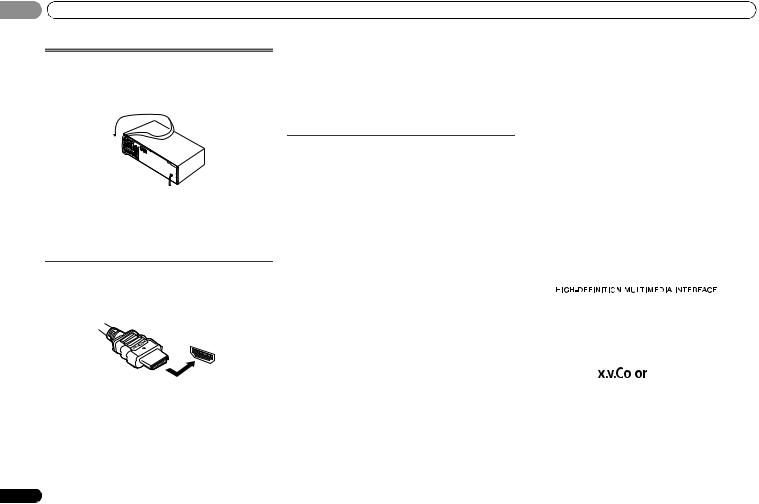
02 Connecting your equipment
Making cable connections
Make sure not to bend the cables over the top of this unit (as shown in the illustration). If this happens, the magnetic field produced by the transformers in this unit may cause a humming noise from the speakers.
 Important
Important
•Before making or changing connections, switch off the power and disconnect the power cord from the AC outlet.
•Before unplugging the power cord, switch the power into standby.
HDMI cables
Both video and sound signals can be transmitted simultaneously with one cable. If connecting the player and the TV via this receiver, for both connections, use HDMI cables.
HDMI
Be careful to connect the terminal in the proper direction.
 Note
Note
•Set the HDMI parameter in Setting the Audio options on page 25 to THRU (THROUGH) and set the input signal in
Selecting the audio input signal on page 18 to HDMI, if you want to hear HDMI audio output from your TV (no sound will be heard from this receiver).
12
•If the video signal does not appear on your TV, try adjusting the resolution settings on your component or display. Note that some components (such as video game units) have resolutions that may not be displayed. In this case, use a (analog) composite connection.
•When the video signal from the HDMI is 480i, 480p, 576i or 576p, Multi Ch PCM sound and HD sound cannot be received.
About HDMI
The HDMI connection transfers uncompressed digital video, as well as almost every kind of digital audio that the connected component is compatible with, including DVDVideo, DVD-Audio, SACD, Dolby Digital Plus, Dolby TrueHD, DTS-HD Master Audio (see below for limitations), Video CD/ Super VCD and CD.
This receiver incorporates High-Definition Multimedia Interface (HDMI®) technology.
This receiver supports the functions described below through HDMI connections.
•Digital transfer of uncompressed video (contents protected by HDCP (1080p/24, 1080p/60, etc.))
•3D signal transfer
•Deep Color signal transfer
•x.v.Color signal transfer
•Audio Return Channel (see The HDMI Setup menu on page 30)
•Input of multi-channel linear PCM digital audio signals (192 kHz or less) for up to 8 channels
•Input of the following digital audio formats:
–Dolby Digital, Dolby Digital Plus, DTS, High bitrate audio (Dolby TrueHD, DTS-HD Master Audio), DVDAudio, CD, SACD (DSD 2 ch only), Video CD, Super VCD.
•4K signal transfer
–This may not operate properly, depending on the connected equipment.
–4K 24p, 4K 25p and 4K 30p signals are supported.
 Note
Note
•Use a High Speed HDMI®/™ Cable. If HDMI cable other than a High Speed HDMI®/™ Cable is used, it may not work properly.
•When an HDMI cable with a built-in equalizer is connected, it may not operate properly.
•3D, Deep Color, x.v.Color, 4K signal transfer and Audio Return Channel are only possible when connected to a compatible component.
•HDMI format digital audio transmissions require a longer time to be recognized. Due to this, interruption in the audio may occur when switching between audio formats or beginning playback.
•Turning on/off the device connected to this unit’s HDMI OUT terminal during playback, or disconnecting/ connecting the HDMI cable during playback, may cause noise or interrupted audio.



 ®
®
The terms HDMI and HDMI High-Definition Multimedia Interface, and the HDMI Logo are trademarks or registered trademarks of HDMI Licensing, LLC in the United States and other countries.
“x.v.Color” and |
are trademarks of Sony |
Corporation.
En
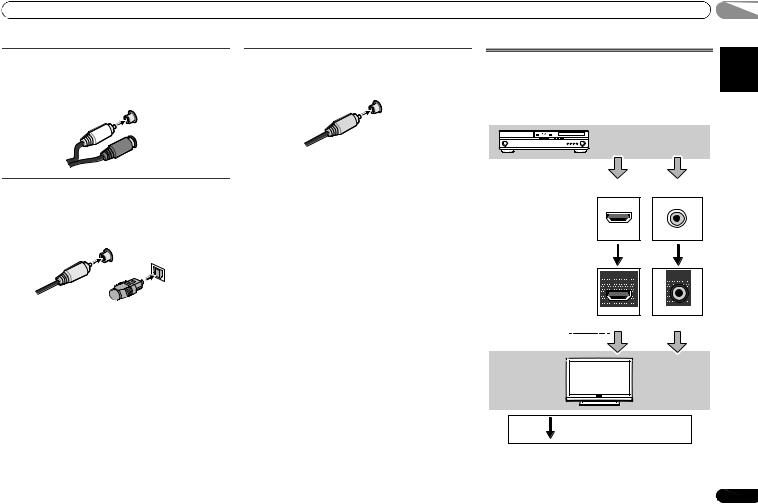
Connecting your equipment |
0202 |
Analog audio cables
Use stereo RCA phono cables to connect analog audio components. These cables are typically red and white, and you should connect the red plugs to R (right) terminals and white plugs to L (left) terminals.
White (Left)
L |
|
R |
AUDIO |
|
Red (Right)
Digital audio cables
Commercially available coaxial digital audio cables or optical cables should be used to connect digital components to this receiver.
Coaxial digital |
COAXIAL |
|
IN |
OPTICAL |
|
audio cable |
|
|
|
|
|
|
|
IN |

 Optical cable
Optical cable
 Note
Note
•When connecting optical cables, be careful when inserting the plug not to damage the shutter protecting the optical socket.
•When storing optical cable, coil loosely. The cable may be damaged if bent around sharp corners.
•You can also use a standard RCA video cable for coaxial
digital connections.
Standard RCA video cables
These cables are the most common type of video connection and are used to connect to the composite video terminals. The yellow plugs distinguish them from cables for audio.
VIDEO
Yellow
About video outputs connection
This receiver is not loaded with a video converter. When you use HDMI cables for connecting to the input device, the same cables should be used for connecting to the TV.
The signals input from the analog (composite) video inputs of this unit will not be output from the HDMI OUT.
Playback component
Terminal for connection with |
IN |
IN |
|
|
|
source device |
|
|
|
HDMI |
VIDEO |
|
OUT |
MONITOR |
|
OUT |
|
|
|
|
Terminal for connection |
|
|
with TV monitor |
|
|
|
HDMI |
VIDEO |
The OSD will not appear.
TV
Video signals can be output.
Español Français English
13
En
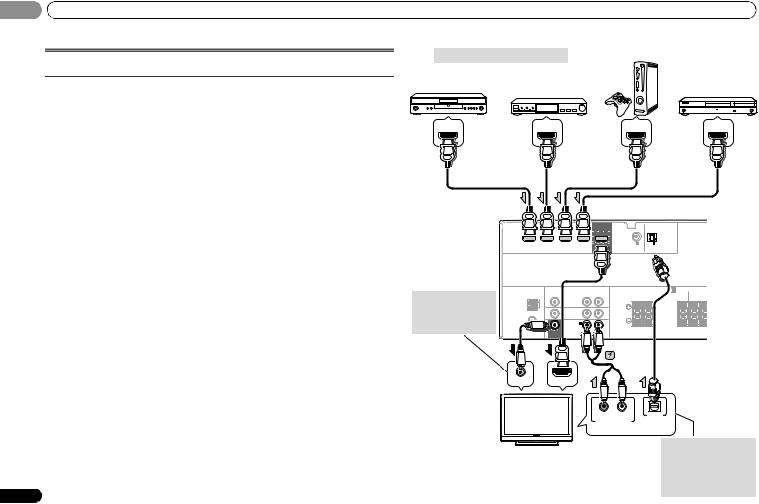
02 Connecting your equipment
Connecting a TV and playback components
Connecting using HDMI
If you have an HDMI or DVI (with HDCP) equipped component (Blu-ray Disc player, etc.), you can connect it to this receiver using a commercially available HDMI cable.
•The following connection/setting is required to listen to the sound of the TV over this receiver.
-If the TV does not support the HDMI Audio Return Channel function, Connect the receiver and TV with audio cables (as shown).
-If the TV supports the HDMI Audio Return Channel function, the sound of the TV is input to the receiver via the HDMI terminal, so there is no need to connect an audio cable. In this case, set ARC at HDMI Setup to ON (see The HDMI Setup menu on page 30).
 Important
Important
•If the receiver is connected to a TV using an HDMI cable, the on-screen display (OSD) will not be displayed. Be sure to use a standard RCA analog video cable to connect. In this case, switch the TV input to analog to see the OSD screen (for setup, etc.) on the TV.
•When the ARC function is ON and the receiver is connected to a compatible TV with an HDMI cable, and you switch the input of the TV to composite, the input of the receiver may automatically switch to TV. If this happens, switch the receiver’s input back to the original input, or turn OFF the ARC function (see The HDMI Setup menu on page 30).
 Note
Note
•In order to listen to the audio from the TV that is connected to this receiver using an analog audio cables, set-up for analog audio input is required (see The Input Assign menu on page 29).
HDMI/DVI-compatible components |
Game console |
||
|
|||
DVD player, |
|
Blu-ray Disc player, |
|
HDD/DVD recorder |
Set-top box |
||
Blu-ray Disc recorder |
|||
|
|||
HDMIOUT |
HDMIOUT |
HDMIOUT |
|
This connection is necessary in order to see the OSD of the unit on the TV.
HDMI |
IN |
|
IN |
OUT |
|
|
|
DVD |
SAT/CBL |
GAME |
BD |
ASSIGNABLE |
IN 1 |
IN 1 |
ASSIGNABLE |
|
|
|
|
(CD) |
(TV) |
COAXIAL OPTICAL
ANTENNA |
VIDEO |
AUDIO |
|
AM LOOP |
|
R |
L |
|
|
|
|
|
|
DVD IN |
|
|
|
SAT/CBL |
|
|
|
IN |
|
|
|
ANALOG IN 1 |
|
FM UNBAL |
|
(CD) |
|
75 |
MONITOR |
ASSIGNABLE |
|
|
|
|
|
|
OUT |
|
|
SPEAKERS A
FRONT |
|
R |
L |
CENTER SURROUN
R |
L |
VIDEOIN HDMIIN
R |
L |
OPTICAL |
ANALOGAUDIOOUT DIGITALAUDIOOUT
Select one
HDMI/DVI-compatible TV
14
If the TV does not support the HDMI Audio Return Channel function, this connection is required to listen to the TV sound over the receiver.
En

Connecting your equipment |
0202 |
Connecting your component with no HDMI terminal
This diagram shows connections of a TV and DVD player (or other playback component) with no HDMI terminal to the receiver.
 Note
Note
•In order to listen to the audio from the TV that is connected to this receiver using a analog audio cables, set-up for analog audio input is required (see The Input Assign menu on page 29).
•You can only connect one component to the optical input terminal. If connecting other devices, please use a different method to connect the audio.
In order to listen to the audio from the source component that is connected to this receiver using an optical cable, first, switch to the DVD (DVD player) or SAT/CBL (set-top box), then press SIGNAL SEL to choose the audio signal O1 (OPTICAL1) (see Selecting the audio input signal on page 18).
•You can only connect one component to the coaxial input terminal. If connecting other devices, please use a different method to connect the audio. In order to listen to the audio from the source component that is connected to this receiver using a coaxial cable, first, switch to the DVD (DVD player) or SAT/CBL (set-top box), then press SIGNAL SEL to choose the audio signal C1 (COAXIAL1) (see Selecting the audio input signal on page 18). In order to listen to the audio from the DVD player that is connected to this receiver using a coaxial cable, first, switch to the DVD input, then press SIGNAL SEL to choose the audio signal C1 (COAXIAL1) (see Selecting the audio input signal on page 18).
|
|
|
DVD player |
|
|
|
Set-top box |
VIDEOOUT |
Select one |
VIDEOOUT |
|
Select one |
|
||
|
|
|
|
||||
ANALOGAUDIOOUT |
DIGITALAUDIOOUT |
ANALOGAUDIOOUT |
DIGITALAUDIOOUT |
||||
R |
L |
OPTICAL |
COAXIAL |
R |
L |
OPTICAL |
COAXIAL |
HDMI |
IN |
IN |
|
OUT |
|
|
|
|
|
|
DVD |
SAT/CBL |
GAME |
BD |
ASSIGNABLE |
IN 1 |
|
IN 1 |
ASSIGNABLE |
|
|
|
|
|
|
(CD) |
|
(TV) |
|
|
||
|
|
|
|
|
COAXIAL OPTICAL |
|
|
|
||
ANTENNA |
|
|
|
|
|
SPEAKERS A |
|
|
||
|
AM LOOP |
|
|
|
FRONT |
|
CENTER |
SURROUND |
||
|
|
|
|
R |
L |
|
|
R |
L |
|
|
|
DVD IN |
|
|
|
|
||||
|
|
|
|
|
|
|
|
|
|
|
|
|
SAT/CBL |
|
|
|
|
|
|
|
|
|
|
IN |
|
|
|
|
|
|
|
|
|
|
ANALOG IN 1 |
|
|
|
|
|
|
|
|
|
|
(CD) |
|
|
|
|
|
|
|
|
|
MONITOR |
ASSIGNABLE |
|
|
|
|
|
|
|
|
|
OUT |
|
|
|
|
|
|
|
|
|
VIDEOIN
R |
L |
OPTICAL |
ANALOGAUDIOOUT DIGITALAUDIOOUT
Select one
TV
This connection is required in order to listen to the sound of the TV over the receiver.
Español Français English
15
En
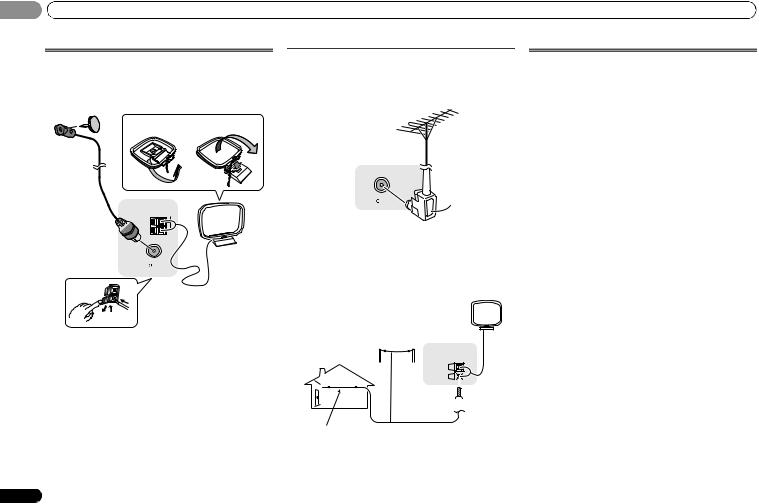
02 Connecting your equipment
Connecting antennas
Connect the AM loop antenna and the FM wire antenna as shown below. To improve reception and sound quality, connect external antennas (see Using external antennas below).
fig. a |
fig. b |
Using external antennas
To improve FM reception
Use a F connector (not supplied) to connect an external FM antenna.
2
ANTENNA
AM LOOP
4 
3
FM UNBAL 75
1
ANTENNA
FM UNBAL |
F connector |
75 |
|
To improve AM reception
Connect a 5 m to 6 m (16 ft. to 20 ft.) length of vinyl-coated wire to the AM antenna terminal without disconnecting the supplied AM loop antenna.
For the best possible reception, suspend horizontally outdoors.
1Push open the tabs, then insert one wire fully into each terminal, then release the tabs to secure the AM antenna wires.
2Fix the AM loop antenna to the attached stand.
To fix the stand to the antenna, bend in the direction indicated by the arrow (fig. a) then clip the loop onto the stand (fig. b).
3Place the AM antenna on a flat surface and in a direction giving the best reception.
4Connect the FM wire antenna into the FM antenna
socket.
For best results, extend the FM antenna fully and fix to a wall or door frame. Don’t drape loosely or leave coiled up.
16
Outdoor antenna
ANTENNA
AM LOOP
|
|
|
|
|
|
|
|
|
|
|
|
|
|
|
|
|
|
|
|
|
|
|
|
|
|
|
|
|
|
|
5 m to 6 m |
|
|
|
|
|
|
|
|
|
|
|
|
|
|
|
|
|
|
|
|
|
|
|
|
|
|
|
|
Indoor antenna |
|
|
|
|
|||||||
(vinyl-coated wire) |
(16 ft. to 20 ft.) |
|
|
|
|
||||||
Connecting an iPod
This receiver has a dedicated iPod/iPhone terminal that will allow you to control playback of audio content from your iPod using the controls of this receiver.
 Note
Note
•An iPod/iPhone can be connected to the receiver. For details on supported models and versions of the respective products, see Playing an iPod on page 19.
1 Switch the receiver into standby, and then use the iPod cable to connect your iPod to the iPod/iPhone terminal on the front panel of this receiver.
•For the cable connection, also refer to the operating instructions for your iPod.
•When connecting an iPhone to this unit, keep the iPhone at least 20 cm away from this unit. If the iPhone is kept closer to this unit and a telephone call is received by the iPhone, noise may be output from this device.
•iPod recharging occurs whenever an iPod is connected to this unit. (Recharging is enabled only when the unit’s power is turned on.)
En

Connecting your equipment |
0202 |
•For instructions on playing the iPod, see Playing an iPod on page 19.
AV RECEIVER VSX-324
HDMI |
iPod iPhone |
T |
ENTER |
MASTER
VOLUME
5V 1A
This receiver
USB cable that comes with the iPod
iPod/iPhone
 Note
Note
•When the ARC function is ON and the receiver is connected to a compatible TV with an HDMI cable, and you switch the input of the TV when the receiver’s selection is iPod/USB input, the receiver may automatically switch to TV. If this happens, switch the receiver's input back to the original input, or turn OFF the ARC function (see The HDMI Setup menu on page 30).
Connecting a USB device
It is possible to listen to two-channel audio using the USB interface on the front of this receiver.
1 Switch the receiver into standby then connect your USB device to the iPod/iPhone terminal on the front panel of this receiver.
•This receiver does not support a USB hub.
•For instructions on playing the USB device, see Playing a USB device on page 20.
AV RECEIVER VSX-324
HDMI |
iPod iPhone |
T |
ENTER |
MASTER
VOLUME
5V 1A
This receiver
USB mass storage device
Plugging in the receiver
Only plug in after you have connected all your components to this receiver, including the speakers.
1 Plug the AC power cord into a convenient AC power outlet.
 CAUTION
CAUTION
•Handle the power cord by the plug. Do not pull out the plug by tugging the cord and never touch the power cord when your hands are wet as this could cause a short circuit or electric shock. Do not place the unit, a piece of furniture, etc., on the power cord, or pinch the cord. Never make a knot in the cord or tie it with other cords. The power cords should be routed such that they are not likely to be stepped on. A damaged power cord can cause a fire or give you an electrical shock. Check the power cord once in a while. When you find it damaged, ask your nearest PIONEER authorized service center or your dealer for a replacement.
•The receiver should be disconnected by removing the mains plug from the wall socket when not in regular use, e.g., when on vacation.
 Note
Note
•After this receiver is connected to an AC outlet, a 2 second to 10 second HDMI initialization process begins. You cannot carry out any operations during this process. The HDMI indicator in the front panel display blinks during this process, and you can turn on this receiver once it has stopped blinking. When you set ARC at HDMI setup to OFF, you can skip this process. For details, see
The HDMI Setup menu on page 30.
Español Français English
17
En
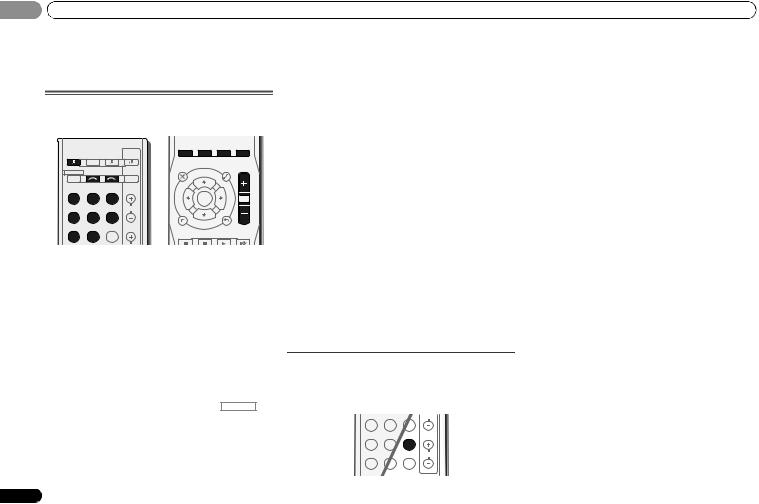
03 Basic playback
Chapter 3:
Basic playback
Playing a source
Here are the basic instructions for playing a source (such as a DVD disc) with your home theater system.
|
|
|
|
AUTO/ |
|
ALC/ |
|
|
|
|
|
DIRECT |
STEREO |
STANDARD |
ADV SURR |
RECEIVER SLEEP |
SOURCE |
TV |
|
|
|
ECO |
|
CONTROL |
|
|
|
|
|||
|
|
|
|
AUDIO |
|
TOOLS |
|
RECEIVER |
INPUT SELECT |
|
PARAMETER |
|
MENU |
VOLUME |
|
INPUT |
TOP |
TUNE |
|
|
|||
|
|
|
MENU |
|
|
|
|
BD |
DVD |
CD |
|
T |
|
P |
|
|
|
|
|
E |
|
R |
|
|
|
|
|
S |
ENTER |
E |
|
|
|
|
|
E |
S |
|
|
|
|
|
|
P |
|
E |
|
|
|
|
|
R |
|
T |
|
TUNER |
iPod/USB SAT/CBL |
CH |
|
|
|
||
|
|
|
|
||||
|
|
|
|
HOME |
|
|
|
|
|
|
|
MENU |
TUNE |
BAND |
|
GAME |
TV |
SIGNAL SEL |
|
PTY |
|
||
|
iPod CTRL |
|
RETURN |
|
|||
MUTE
1 Switch on your system components and receiver.
Start by switching on the playback component (for example a DVD player), your TV and subwoofer (if you have one), then the receiver (press RECEIVER).
• Make sure the setup microphone is disconnected.
2Switch the TV input to the input that connects this
receiver.
For example, if you connected this receiver to the VIDEO jacks on your TV, make sure that the VIDEO input is now selected.
3Press input function buttons to select the input function you want to play.
•The input of the receiver will switch over, and you will be able to operate other components using the remote control. To operate the receiver, first press RECEIVER on the remote control, then press the appropriate button to operate.
•The input source can also be selected by using INPUT
SELECT  buttons on the remote control, or by using the front panel INPUT SELECTOR dial. In this case, the remote control won’t switch operational modes.
buttons on the remote control, or by using the front panel INPUT SELECTOR dial. In this case, the remote control won’t switch operational modes.
18
If you selected the proper input source and there is still no sound, select the audio input signal for playback (see
Selecting the audio input signal below).
4 Press AUTO/DIRECT to select ‘AUTO SURROUND’ and
start playback of the source.
If you’re playing a Dolby Digital or DTS surround sound DVD disc, with a digital audio connection, you should hear surround sound. If you’re playing a stereo source or if the connection is an analog audio connection, you will only hear sound from the front left/right speakers in the default listening mode.
It is possible to check on the front panel display whether or not surround sound playback is being performed properly.
If the display does not correspond to the input signal and listening mode, check the connections and settings.
 Note
Note
•You may need to check the digital audio output settings on your DVD player or digital satellite receiver. It should be set to output Dolby Digital, DTS and 88.2 kHz/96 kHz PCM (2 channel) audio, and if there is an MPEG audio option, set this to convert the MPEG audio to PCM.
•Depending on your DVD player or source discs, you may only get digital 2 channel stereo and analog sound. In this case, the receiver must be set to a multichannel listening mode if you want multichannel surround sound.
5 Use VOLUME +/– to adjust the volume level.
Turn down the volume of your TV so that all sound is coming from the speakers connected to this receiver.
Selecting the audio input signal
The audio input signal can be selected for each input source. Once it is set, the audio input that was selected will be applied whenever you select the input source using the input function buttons.
TUNER |
iPod/USB SAT/CBL |
CH |
|
GAME |
TV |
SIGNAL SEL |
|
Acous.EQ |
S.RETRIEVER |
PHASE |
VOL |
1 Press SIGNAL SEL to select the audio input signal
corresponding to the source component.
Each press cycles through the following:
•H – Selects an HDMI signal. H can be selected for BD, DVD, SAT/CBL and GAME input. For other inputs, H cannot be selected.
-When the HDMI option in Setting the Audio options on page 25 is set to THRU, the sound will be heard through your TV, not from this receiver.
•A – Selects the analog inputs.
•C1/O1 – Selects the digital input. The coaxial 1 input is selected for C1, and the optical 1 audio input is selected for O1.
When H (HDMI) or C1/O1 (digital) is selected and the selected audio input is not provided, A (analog) is automatically selected.
Except BD, DVR/BDR input.
 Note
Note
•BD and GAME inputs are fixed to H (HDMI). It cannot be changed.
•For the TV input, only A (analog) or C1/O1 (digital) can be selected. However, if the ARC at HDMI Setup is set to ON, the input is fixed to H (HDMI) and cannot be changed.
•When set to H (HDMI) or C1/O1 (digital), 2lights when a Dolby Digital signal is input, and DTS lights when a DTS signal is input.
•When the H (HDMI) is selected, the A and DIGITAL indicators are off (see page 7).
En
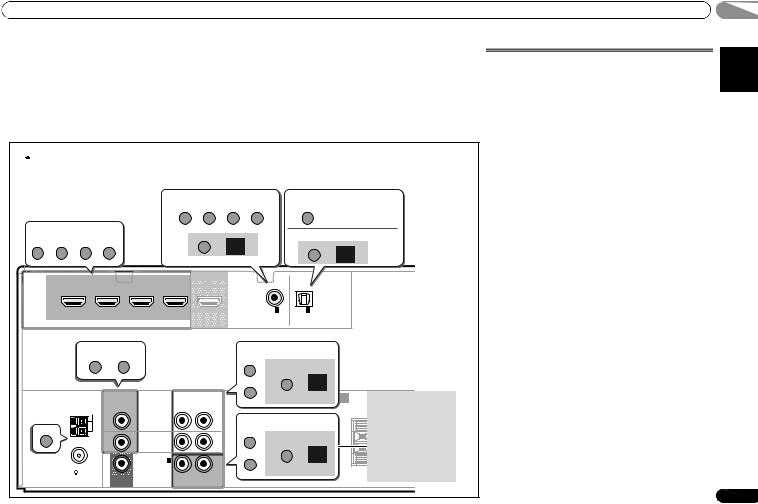
Basic playback |
0303 |
•When digital input (optical or coaxial) is selected, this receiver can only play back Dolby Digital, PCM (32 kHz to 96 kHz) and DTS (including DTS 96 kHz/24 bit) digital signal formats. The compatible signals via the HDMI terminals are: Dolby Digital, DTS, SACD (DSD 2ch only), PCM (32 kHz to 192 kHz sampling frequencies), Dolby TrueHD, Dolby Digital Plus, DTS-EXPRESS, DTS-HD Master Audio and DVD Audio (including 192 kHz). With other digital signal formats, set to A (analog).
•You may get digital noise when a LD or CD player compatible with DTS is playing an analog signal. To prevent noise, make the proper digital connections (page 13) and set the signal input to C1/O1 (digital).
•Some DVD players don’t output DTS signals. For more details, refer to the instruction manual supplied with your DVD player.
 Tip
Tip
•In order to enjoy the picture and/or sound from devices
connected to each terminal, select the input by doing the following.
|
Audio |
|
|
DVD CD SAT/CBL TV |
|
Video/Audio (HDMI) |
SIGNAL SEL |
|
DVD SAT/CBL GAME BD |
||
C1 |
||
|
Audio
1. TV
(TV input)
2.Other than TV input
SIGNAL SEL
O1
HDMI |
IN |
|
IN |
|
|
|
DVD |
SAT/CBL |
GAME |
BD |
IN 1 |
IN 1 |
|
(CD) |
(TV) ASSIGNABLE |
|||||
|
|
|
ASSIGNABLE |
|||
|
|
|
|
COAXIAL OPTICAL |
||
|
Video |
|
Audio |
|
||
|
|
|
|
|||
|
SAT/CBL DVD |
|
DVD |
|
|
|
|
|
|
|
|
||
|
|
|
|
SIGNAL SEL |
|
|
|
|
|
SAT/CBL |
A |
|
|
ANTENNA |
VIDEO |
AUDIO |
A |
ANALOG IN1 audio |
||
|
|
R |
L |
CENTER |
input terminal is |
|
AM LOOP |
|
SURROUND |
||||
|
|
|
|
R |
L |
|
|
|
DVD IN |
Audio |
|
assigned to CD under |
|
|
|
|
factory settings. If you |
|||
TUNER |
|
|
CD |
|
||
|
|
|
want to change this to |
|||
|
|
SAT/CBL |
|
|||
|
|
|
|
TV input, please |
||
|
|
IN |
|
SIGNAL SEL |
||
|
|
ANALOG IN 1 |
TV |
A |
change the settings in |
|
|
|
|
|
the Input Assign menu |
||
FM UNBAL |
|
(CD) |
|
|
||
75 |
MONITOR |
ASSIGNABLE |
|
|
(page 29). |
|
|
|
|
|
|
|
|
|
OUT |
|
|
|
|
|
Playing an iPod
This receiver has a dedicated iPod/iPhone terminal that will allow you to control playback of audio content from your iPod using the controls of this receiver.
 Important
Important
•Pioneer cannot under any circumstances accept responsibility for any direct or indirect loss arising from any inconvenience or loss of recorded material resulting from the iPod failure.
 Note
Note
•This receiver is compatible with the audio of the iPod touch (1st/2nd/3rd/4th/5th generation), iPod classic, iPod nano (3rd/4th/5th/6th/7th generation), iPhone 3G, iPhone 3GS, iPhone 4, iPhone 4S, iPhone 5 and iPad mini. However, that some of the functions may be restricted for some models.
•This receiver has been developed and tested for the software version of iPod/iPhone indicated on the website of Pioneer (http://pioneer.jp/homeav/support/ios/na/).
•Installing software versions other than indicated on the website of Pioneer to your iPod/iPhone may result in incompatibility with this receiver.
•iPod and iPhone are licensed for reproduction of noncopyrighted materials or materials the user is legally permitted to reproduce.
•Features such as the equalizer cannot be controlled using this receiver, and we recommend switching the equalizer off before connecting.
•No sound will come from the headphone even when the headphone is connected to the PHONES jack, when the iPod is connected.
•Make sure the receiver is in standby when disconnecting the iPod/iPhone.
1Switch on the receiver and your TV.
See Connecting an iPod on page 16.
2Switch the TV input so that it connects to the receiver.
•Switch the TV input to the input that connects this receiver to the TV through the corresponding composite cable.
Español Français English
19
En
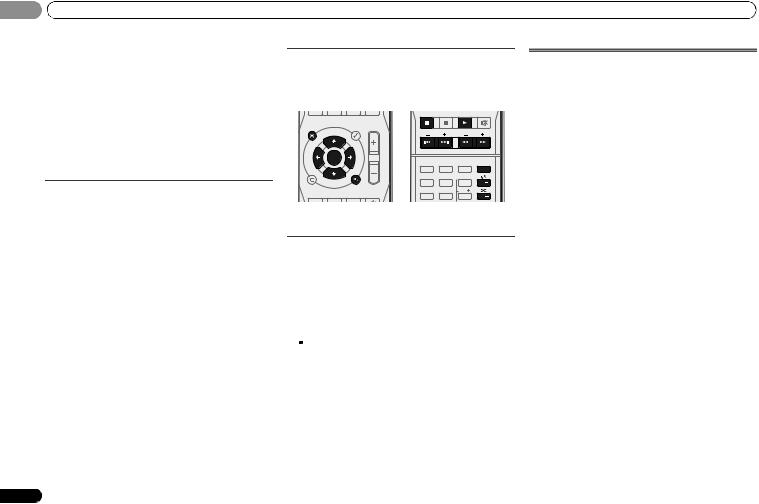
03 Basic playback
3Press iPod/USB to switch the receiver to the iPod/USB
input.
The front panel display shows Loading while the receiver verifies the connection and retrieves data from the iPod.
4Use TOP MENU to display iPod Top menu.
When the display shows Top Menu you’re ready to play music from the iPod.
•If after pressing iPod/USB the display shows NO DEVICE, try switching off the receiver and reconnecting the iPod to the receiver.
•The controls of your iPod will be inoperable when connected to this receiver.
Playing back files stored on an iPod
To navigate songs on your iPod, you can take advantage of the OSD of your TV connected to this receiver. You can also control all operations for music in the front panel display of this receiver.
•Note that non-roman characters in the title are displayed as ‘*’.
•This feature is not available for photos or video clips on your iPod.
Finding what you want to play
When your iPod is connected to this receiver, you can browse songs stored on your iPod by playlist, artist, album name, song name, genre or composer, similar to using your iPod directly.
1Use / to select a category, then press ENTER to browse that category.
•To return to the previous level any time, press RETURN.
2Use /to browse the selected category (e.g., albums).
•Use / to move to previous/next levels.
3Continue browsing until you arrive at what you want to play, then press to start playback.
•If you’re in the song category, you can also press ENTER to start playback.
•You can play all of the songs in a particular category by selecting the All item at the top of each category list. For example, you can play all the songs by a particular artist.
20
Basic playback controls
This receiver’s remote control buttons can be used for basic playback of files stored on an iPod.
•Press iPod/USB to switch the remote control to the iPod/ USB operation mode.
|
|
ECO |
MUTE |
AUDIO |
|
TOOLS |
|
PARAMETER |
|
MENU VOLUME |
|
TOP |
TUNE |
BASS |
TRE |
MENU |
|
|
|
T |
|
P |
|
|
|
|
E |
|
R |
|
|
|
|
S |
ENTER |
E |
|
|
|
|
E |
S |
|
|
|
|
|
P |
|
E |
|
|
|
|
R |
|
T |
|
|
|
|
|
|
1 |
2 |
3 |
|
|
|
|
|
DISP |
|||
HOME |
|
|
|
SB CH |
CH SELECT |
|
MENU |
TUNE |
BAND |
4 |
5 |
6 |
CH |
PTY |
|
|||||
iPod CTRL |
|
RETURN |
MIDNIGHT SPEAKERS |
LEV |
|
|
|
|
MUTE |
|
|||
|
|
7 |
8 |
9 |
CH |
|
• During Audiobook playback, press / to switch the playback speed: Faster  Normal
Normal  Slower
Slower
Switches between the iPod controls and the receiver controls
This allows you to switch between performing iPod operations via the receiver remote control or on the iPod itself.
1Press iPod CTRL to switch to the iPod controls.
•Press iPod CTRL again to switch back to the receiver controls when you’re done.
 Tip
Tip
•Change the receiver’s input to the iPod in one action by pressing iPod iPhone DIRECT CONTROL on the front
panel to enable iPod operations on the iPod.
Playing a USB device
It is possible to listen to two-channel audio using the USB interface on the front of this receiver.
 Important
Important
•Pioneer cannot guarantee compatibility (operation and/or bus power) with all USB mass storage devices and assumes no responsibility for any loss of data that may occur when connected to this receiver.
 Note
Note
•This includes playback of WMA/MP3/MPEG-4 AAC files (except files with copy-protection or restricted playback).
•Compatible USB devices include external magnetic hard drives, portable flash memory (particularly keydrives) and digital audio players (MP3 players) of format FAT16/32. It is not possible to connect this receiver to a personal computer for USB playback.
•With large amounts of data, it may take longer for the receiver to read the contents of a USB device.
•If the file selected cannot be played back, this receiver automatically skips to the next file playable.
•When the file currently being played back has no title assigned to it, the file name is displayed in the OSD instead; when neither the album name nor the artist name is present, the row is displayed as a blank space.
•Note that non-roman characters in the playlist are displayed as ‘*’.
•Make sure the receiver is in standby when disconnecting the USB device.
1Switch on the receiver and your TV.
See Connecting a USB device on page 17.
2Switch the TV input so that it connects to the receiver.
•Switch the TV input to the input that connects this receiver to the TV through the corresponding composite cable.
3Press iPod/USB on the remote control to switch the
receiver to the iPod/USB input.
Loading appears in the OSD as this receiver starts recognizing the USB device connected. After the recognition, a playback screen appears in the OSD and playback starts automatically.
En

Basic playback |
0303 |
Basic playback controls
This receiver’s remote control buttons can be used for basic playback of files stored on an USB devices.
•Press iPod/USB to switch the remote control to the iPod/ USB operation mode.
|
|
ECO |
MUTE |
AUDIO |
|
TOOLS |
|
PARAMETER |
|
MENU VOLUME |
|
TOP |
TUNE |
BASS |
TRE |
MENU |
|
|
|
T |
|
P |
|
|
|
|
E |
|
R |
|
|
|
|
S |
ENTER |
E |
|
|
|
|
E |
S |
|
|
|
|
|
P |
|
E |
|
|
|
|
R |
|
T |
|
|
|
|
|
|
1 |
2 |
3 |
|
|
|
|
|
DISP |
|||
HOME |
|
|
|
SB CH |
CH SELECT |
|
MENU |
TUNE |
BAND |
4 |
5 |
6 |
CH |
PTY |
|
|||||
iPod CTRL |
|
RETURN |
MIDNIGHT SPEAKERS |
LEV |
|
|
|
|
MUTE |
|
|||
|
|
7 |
8 |
9 |
CH |
|
 Important
Important
•If a USB Error message lights in the display, try following the points below:
•Switch the receiver off, then on again.
•Reconnect the USB device with the receiver switched off.
•Select another input source (like BD), then switch back to iPod/USB.
•Use a dedicated AC adapter (supplied with the device) for USB power.
For more information on error messages, see USB messages on page 32
If this doesn’t remedy the problem, it is likely your USB device is incompatible.
Compressed audio compatibility
Note that although most standard bit/sampling rate combinations for compressed audio are compatible, some irregularly encoded files may not play back. The list below shows compatible formats for compressed audio files:
•MP3 (MPEG-1/2/2.5 Audio Layer 3) — Sampling rates: 32 kHz/44.1 kHz/48 kHz; Bit rates: 32 kbps to 320 kbps (128 kbps or higher recommended); File extension: .mp3
•WMA (Windows Media Audio) — Sampling rates: 32 kHz/ 44.1 kHz/48 kHz; Bit rates: 48 kbps to 192 kbps (128 kbps or higher recommended); File extension: .wma; WMA9
Pro and WMA lossless encoding: No
•AAC (MPEG-4 Advanced Audio Coding) — Sampling rates: 32 kHz/44.1 kHz/48 kHz; Bit rates: 16 kbps to 320 kbps (128 kbps or higher recommended); File extension:
.m4a; Apple lossless encoding: No
Other compatibility information
•VBR (variable bit rate) MP3/WMA/MPEG-4 AAC playback: Yes (Note that in some cases playback time will not be displayed correctly.)
•DRM (Digital Rights Management) protection compatible: Yes (DRM-protected audio files will not play in this receiver.)
About MPEG-4 AAC
Advanced Audio Coding (AAC) is at the core of the MPEG-4 AAC standard, which incorporates MPEG-2 AAC, forming the basis of the MPEG-4 audio compression technology. The file format and extension used depend on the application used to encode the AAC file. This receiver plays back AAC files
encoded by iTunes® bearing the extension ‘.m4a’. DRMprotected files will not play, and files encoded with some
versions of iTunes® may not play.
Apple and iTunes are trademarks of Apple Inc., registered in the U.S. and other countries.
About WMA
WMA is an acronym for Windows Media Audio and refers to an audio compression technology developed by Microsoft Corporation. This receiver plays back WMA files encoded
using Windows Media® Player bearing the extension ‘.wma’. Note that DRM-protected files will not play, and files encoded
with some versions of Windows Media® Player may not play.
Listening to the radio
The following steps show you how to tune in to FM and AM radio broadcasts using the automatic (search) and manual (step) tuning functions. Once you are tuned to a station you can memorize the frequency for recall later—see Saving station presets below for more on how to do this.
TUNER |
iPod/USB SAT/CBL |
CH |
|
GAME |
TV |
SIGNAL SEL |
|
Acous.EQ |
S.RETRIEVER |
PHASE |
VOL |
AUDIO
PARAMETER
TOP
MENU
T
E
S
E
R
P
HOME
MENU
PTY
iPod CTRL
TOOLS
MENU VOLUME
TUNE |
|
|
P |
|
R |
ENTER |
E |
S |
|
|
E |
|
T |
TUNE |
BAND |
|
|
|
RETURN |
MUTE
1Press TUNER to select the tuner.
2Use BAND to change the band (FM or AM), if necessary.
Each press switches the band between FM (stereo or mono) and AM.
3Tune to a station.
There are three ways to do this:
Automatic tuning
To search for stations in the currently selected band, press and hold TUNE / for about a second. The receiver will start searching for the next station, stopping when it has found one. Repeat to search for other stations.
Manual tuning
To change the frequency one step at a time, press
TUNE /.
High speed tuning
Press and hold TUNE / for high speed tuning.
Improving FM sound
If the TUNE or ST indicators don’t light when tuning to an FM station because the signal is weak, set the receiver to the mono reception mode.
1 Press BAND to select FM MONO.
This should improve the sound quality and allow you to enjoy the broadcast.
Español Français English
21
En
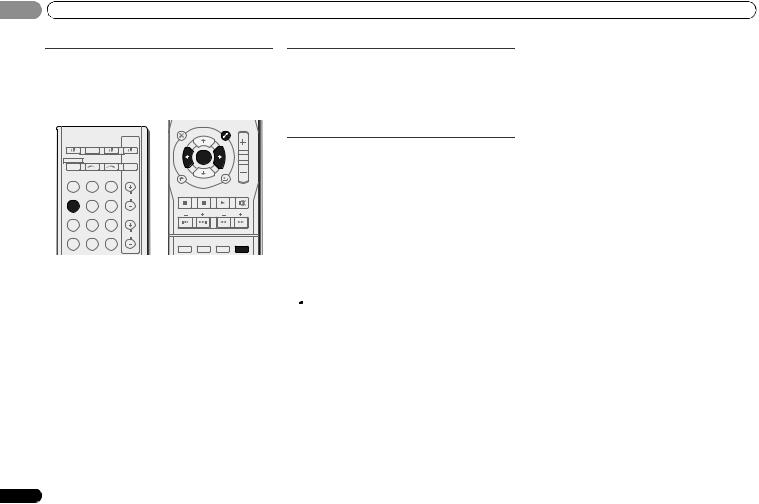
03 Basic playback
Saving station presets
If you often listen to a particular radio station, it’s convenient to have the receiver store the frequency for easy recall whenever you want to listen to that station. This saves the effort of manually tuning in each time. This unit can memorize up to 30 stations.
AUDIO |
TOOLS |
PARAMETER |
MENU VOLUME |
|
TOP |
TUNE |
|
MENU |
|
RECEIVER |
TV |
|
SLEEP SOURCE CONTROL |
|
|
|
|
T |
|
|
P |
|
|
|
E |
|
|
R |
|
|
|
S |
ENTER |
|
E |
RECEIVER |
INPUT SELECT |
E |
|
S |
||
P |
|
|
E |
|||
|
|
|
R |
|
|
T |
|
|
|
INPUT |
|
|
|
|
|
|
|
|
|
|
BD |
DVD |
CD |
HOME |
|
|
|
MENU |
TUNE |
|
|
|||
|
|
|
|
BAND |
||
|
|
|
PTY |
|
|
|
|
|
|
iPod CTRL |
RETURN |
||
TUNER |
iPod/USB SAT/CBL |
CH |
|
|
MUTE |
|
|
|
|
||||
GAME |
TV |
SIGNAL SEL |
|
BASS |
|
TRE |
|
|
|
|
|||
Acous.EQ |
S.RETRIEVER |
PHASE |
VOL |
|
|
|
|
|
|
1 |
2 |
3 |
DISP |
1 Tune to a station you want to memorize.
See Listening to the radio on page 21 for more on this.
2 Press TOOLS.
The display shows PRESET, then a blinking MEM and station preset.
3Press PRESET / to select the station preset you
want.
You can also use the number buttons.
4Press ENTER.
The preset number stop blinking and the receiver stores the station.
 Note
Note
•If the receiver is left disconnected from the AC power outlet for over a month, the station memories will be lost and will have to be reprogrammed.
•Stations are stored in stereo. When the station is stored in the FM MONO mode, it shows as ST when recalled.
Listening to station presets
You will need to have some presets stored to do this. See Saving station presets above if you haven’t done this already.
1 Press PRESET / to select the station preset you want.
•You can also use the number buttons on the remote control to recall the station preset.
Naming preset stations
For easier identification, you can name all of your preset stations.
1 Choose the station preset you want to name.
See Listening to station presets above for how to do this.
2 Press TOOLS twice.
The cursor at the first character position is blinking on the display.
3 Input the name you want.
Choose a name up to eight characters long.
•Use PRESET / to select character position.
•Use TUNE / to select characters.
•The name is stored when ENTER is pressed.
 Tip
Tip
•To erase a station name, follow steps 1 and 2, and press ENTER while the display is blank. Press TOOLS while the display is blank, to keep the previous name.
•Once you have named a station preset, Press DISP to show the name. When you want to return to the frequency display, press DISP several times to show the frequency.
22
En
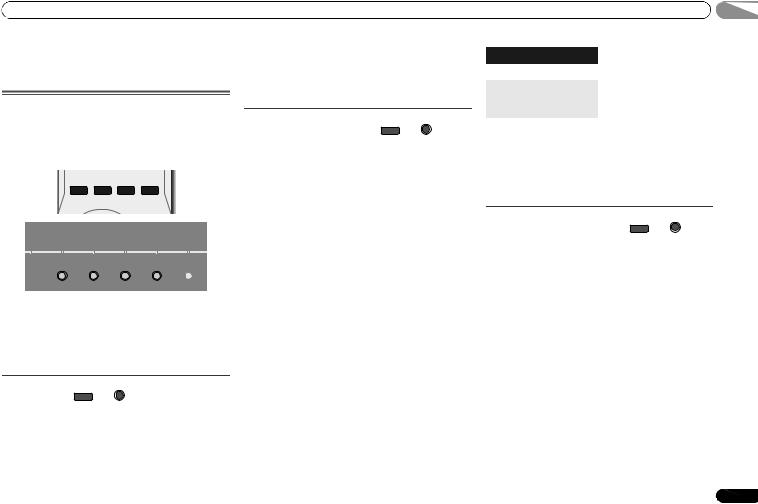
Listening to your system |
0404 |
Chapter 4:
Listening to your system
Choosing the listening mode
This receiver offers a variety of listening modes to accommodate playback of various audio formats. Choose one according to your speaker environment or the source.
1 While listening to a source, press the listening mode button repeatedly to select a listening mode you want.
|
AUTO/ |
|
ALC/ |
|
|
|
DIRECT |
STEREO |
STANDARD |
ADV SURR |
|
|
|
|
|
ECO |
|
|
AUDIO |
|
TOOLS |
|
|
|
PARAMETER |
|
MENU |
VOLUME |
|
DISPLAY |
BAND |
TUNER EDIT |
TUNE |
|
|
AUTO SURROUND/ |
ALC/ |
ADVANCED |
|
iPod iPhone |
|
STREAM DIRECT STANDARD SURR |
SURROUND |
ECO |
DIRECT CONTROL |
||
•The listening mode is shown on the display on the front panel.
 Important
Important
•The listening modes and many features described in this section may not be available depending on the current source, settings and status of the receiver.
Auto playback |
AUTO/ STREAM DIRECT |
|
AUTO SURROUND/ |
|
DIRECT |
The simplest, most direct listening option is the AUTO SURROUND feature. With this, the receiver automatically detects what kind of source you’re playing and selects multichannel or stereo playback as necessary.
•Press AUTO/DIRECT repeatedly until AUTO SURROUND shows briefly in the display (it will then show the decoding or playback format). Check the digital format indicators in the display to see how the source is being processed.
 Note
Note
•Stereo surround (matrix) formats are decoded accordingly using NEO:6 CINEMA (see Listening in surround sound below for more on these decoding formats).
Listening in surround sound ALC/ ALC/
STANDARD
STANDARD SURR
Using this receiver, you can listen to any source in surround sound. However, the options available will depend on your speaker setup and the type of source you’re listening to.
•If the source is Dolby Digital, DTS, or Dolby Surround encoded, the proper decoding format will automatically be selected and shows in the display.
When you select STEREO ALC (Auto Level Control stereo mode), this unit equalizes playback sound levels if each sound level varies with the music source recorded in a portable audio player.
When you select STEREO, you will hear the source through just the front left and right speakers (and possibly your subwoofer depending on your speaker settings). Dolby Digital and DTS multichannel sources are downmixed to stereo.
The following modes provide basic surround sound for stereo and multichannel sources.
Explanatory notes
No: No connected / Yes: Connected / Two: Two speakers are connected / –: Whether connected or no
Type of surround modes |
Suitable sources |
Two channel sources |
|
|
|
STEREO ALC |
See above. |
DOLBY PLII MOVIE |
Movie |
DOLBY PLII MUSICa |
Music |
DOLBY PLII GAME |
Video games |
NEO:6 CINEMAb |
Movie |
NEO:6 MUSICb |
Music |
DOLBY PRO LOGIC |
Old movies |
Straight Decode |
No additional effects |
STEREOc |
See above. |
Type of surround modes |
Suitable sources |
|
English |
Multichannel sources |
|
|
|
|
|
|
|
|
|
|
|
STEREO ALC |
See above. |
|
|
|
|
|
|
Straight Decode |
No additional effects |
|
|
|
|
|
Français |
STEREOc |
See above. |
||
(see Setting the Audio options on page 25). |
|||
a. You can also adjust the C.WIDTH, DIMEN., and PNRM. effect |
|
||
b. You can also adjust the C.IMG effect (see Setting the Audio |
|
||
|
|||
options on page 25). |
|
|
Español |
still use the Midnight, Loudness, Phase Control, Sound |
|||
c. • You can choose the STEREO mode by using STEREO button.
• The audio is heard with your surround settings and you can Retriever and Tone functions.
Using the Advanced surround ADV SURR |
ADVANCED |
SURROUND |
|
ECO |
|
The Advanced surround feature creates a variety of surround effects. Try different modes with various soundtracks to see which you like.
ACTION |
Designed for action movies with dynamic |
|
soundtracks. |
DRAMA |
Designed for movies with lots of dialog. |
ADVANCED GAME |
Suitable for video games. |
SPORTS |
Suitable for sports programs. |
CLASSICAL |
Gives a large concert hall-type sound. |
ROCK/POP |
Creates a live concert sound for rock and/or |
|
pop music. |
EXT.STEREO |
Gives multichannel sound to a stereo |
|
source, using all of your speakers. |
|
|
23
En
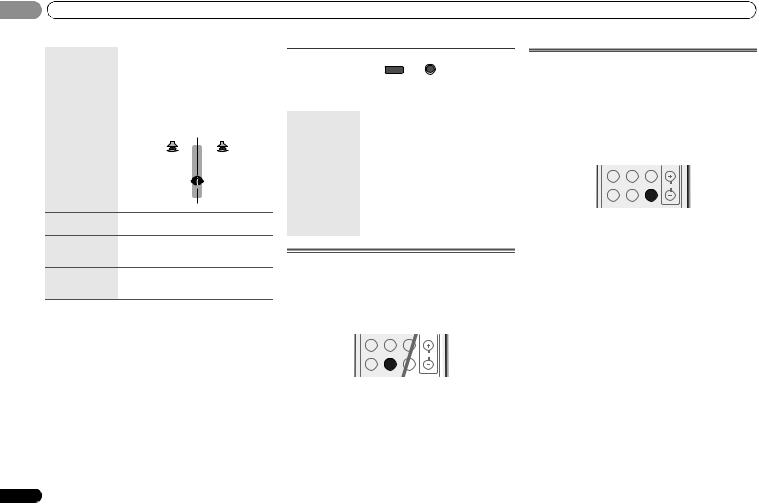
04 Listening to your system
F.S.S.ADVANCE |
Allows you to create natural surround |
|||
(Front Stage |
sound effects using just the front speakers |
|||
Surround |
and the subwoofer. |
|
|
|
ADVANCE) |
Use to provide a rich surround sound effect |
|||
|
directed to the center of where the front left |
|||
|
and right speakers sound projection area |
|||
|
converges. |
|
|
|
|
|
|
|
|
|
|
Front left |
Front right |
|
|
|
speaker |
speaker |
|
|
|
|
|
|
PHONES SURR When listening through headphones, you can still get the effect of overall surround.
ECO MODE 1 Cut back on power consumption. Suitable for contents that are mainly high level (mainly music).
ECO MODE 2 Cut back on even more power consumption than ECO MODE 1. Suitable for contents with wider dynamic range (mainly movies).
 Note
Note
•During ECO mode, the brightness switches between 2 levels. If the dimmest level is selected, DIMMER will be shown on the display. (Mode other than ECO: 4 levels, ECO mode: 2 levels)
•ECO MODE will switch OFF automatically when switched to other listening modes (Advanced surround mode and Auto surround mode).
24
Using Stream Direct AUTO/ AUTO SURROUND/
DIRECT
STREAM DIRECT
Use the Stream Direct modes when you want to hear the truest possible reproduction of a source. All unnecessary signal processing is bypassed.
AUTO SURROUND See Auto playback on page 23.
DIRECT |
Sources are heard according to the settings |
|
made in the Manual SP Setup (speaker |
|
setting, channel level, speaker distance), as |
|
well as with dual mono settings. You will |
|
hear sources according to the number of |
|
channels in the signal. |
|
Phase Control, Sound Delay, Auto Delay, |
|
LFE Attenuate and Center image functions |
|
are available. |
|
|
PURE DIRECT |
Analog and PCM sources are heard without |
|
any digital processing. |
|
|
Using the Sound Retriever
When audio data is removed during the compression process, sound quality often suffers from an uneven sound image. The Sound Retriever feature employs new DSP technology that helps bring CD quality sound back to compressed 2-channel audio by restoring sound pressure and smoothing jagged artifacts left over after compression.
GAME |
TV |
SIGNAL SEL |
|
Acous.EQ |
S.RETRIEVER |
PHASE |
VOL |
1 Press S.RETRIEVER to switch the S.RTV (Sound Retriever) ON or OFF.
 Note
Note
•The Sound Retriever is only applicable to 2-channel sources.
Better sound using Phase Control
This receiver’s Phase Control feature uses phase correction measures to make sure your sound source arrives at the listening position in phase, preventing unwanted distortion and/or coloring of the sound.
Phase Control technology provides coherent sound reproduction through the use of phase matching for an optimal sound image at your listening position. The default setting is on and we recommend leaving Phase Control switched on for all sound sources.
GAME |
TV |
SIGNAL SEL |
|
Acous.EQ |
S.RETRIEVER |
PHASE |
VOL |
1 Press PHASE to switch the P.CTL (Phase Control) ON or OFF.
 Note
Note
•Phase matching is a very important factor in achieving proper sound reproduction. If two waveforms are ‘in phase’, they crest and trough together, resulting in increased amplitude, clarity and presence of the sound signal. If a crest of a wave meets a trough, then the sound will be ‘out of phase’ and an unreliable sound image will be produced.
•If your subwoofer has a phase control switch, set it to the plus (+) sign (or 0º). However, the effect you can actually feel when Phase Control is set to ON on this receiver depends on the type of your subwoofer. Set your subwoofer to maximize the effect. It is also recommended you try changing the orientation or the place of your subwoofer.
•Set the built-in lowpass filter switch of your subwoofer to OFF. If this cannot be done on your subwoofer, set the cutoff frequency to a higher value.
•If the speaker distance is not properly set, you may not have a maximized Phase Control effect.
•The Phase Control mode cannot be set to ON in the following cases:
-When the PURE DIRECT mode is switched on. -When the headphones are connected.
En
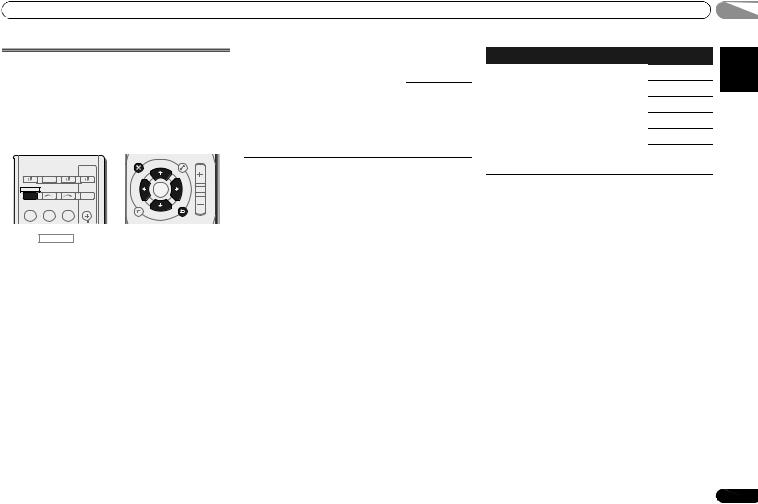
Listening to your system |
0404 |
Setting the Audio options
There are a number of additional sound settings you can make using the AUDIO PARAMETER menu. The defaults, if not stated, are listed in bold.
 Important
Important
•Note that if a setting doesn’t appear in the AUDIO PARAMETER menu, it is unavailable due to the current source, settings and status of the receiver.
AUDIO |
TOOLS |
PARAMETER |
MENU VOLUME |
|
TV |
TOP |
TUNE |
RECEIVER |
MENU |
|
|
SLEEP SOURCE CONTROL |
|
|
|
|
|
|
T |
|
P |
|
|
|
|
E |
|
R |
RECEIVER |
|
|
|
S |
ENTER |
E |
INPUT SELECT |
|
E |
S |
|||
|
|
R |
|
|||
|
|
|
INPUT |
P |
|
E |
|
|
|
|
|
T |
|
BD |
DVD |
CD |
|
HOME |
|
|
|
|
|
|
MENU |
TUNE |
BAND |
|
|
|
|
PTY |
|
|
|
|
|
|
iPod CTRL |
|
RETURN |
1Press RECEIVER , then press AUDIO PARAMETER button.
2Use / to select the setting you want to adjust.
Depending on the current status/mode of the receiver, certain options may not be able to be selected. Check the table below for notes on this.
3Use / to set it as necessary.
See the table below for the options available for each setting.
4 Press RETURN to confirm and exit the menu.
Setting/What it does |
Option(s) |
|
S.DELAY (Sound Delay) |
0 to 500 ms |
|
Some monitors have a slight delay when |
(1 step : 5 ms) |
|
showing video, so the soundtrack will be |
Default: 0 |
|
slightly out of sync with the picture. By adding |
|
|
a bit of delay, you can adjust the sound to |
|
|
match the presentation of the video. |
|
|
|
|
|
MIDNIGHT/LOUDNESSa |
M/L OFF |
|
The MIDNIGHT allows you to hear effective |
|
|
MIDNIGHT |
||
surround sound of movies at low volumes. |
||
|
||
The LOUDNESS is used to get good bass and |
LOUDNESS |
|
treble from music sources at low volumes. |
|
|
|
|
Setting/What it does |
Option(s) |
S.RTV (Sound Retriever)b |
OFFc |
When audio data is removed during the
compression process, sound quality often ON suffers from an uneven sound image. The
Sound Retriever feature employs new DSP technology that helps bring CD quality sound back to compressed 2-channel audio by restoring sound pressure and smoothing jagged artifacts left over after compression.
DUAL MONOd |
CH1 – Channel 1 |
Specifies how dual mono encoded Dolby |
is heard only |
|
|
Digital soundtracks should be played. |
CH2 – Channel 2 |
|
|
|
is heard only |
|
|
|
CH1 CH2 – Both |
|
channels heard |
|
from front |
|
speakers |
F.PCM (Fixed PCM) |
OFF |
|
This is useful if you find there is a slight delay |
|
|
ON |
||
before OFF recognizes the PCM signal on a |
||
|
||
CD, for instance. |
|
|
When ON is selected, noise may be output |
|
|
during playback of non-PCM sources. Please |
|
|
select another input signal if this is a problem. |
|
|
|
|
|
DRC (Dynamic Range Control) |
AUTOe |
|
Adjusts the level of dynamic range for movie |
|
|
soundtracks optimized for Dolby Digital, DTS, |
MAX |
|
Dolby Digital Plus, Dolby TrueHD, DTS-HD |
|
|
MID |
||
and DTS-HD Master Audio (you may need to |
||
|
||
use this feature when listening to surround |
OFF |
|
sound at low volumes). |
||
|
||
|
|
Setting/What it does
LFE ATT (LFE Attenuate)
Some Dolby Digital and DTS audio sources include ultra-low bass tones. Set the LFE attenuator as necessary to prevent the ultralow bass tones from distorting the sound from the speakers.
The LFE is not limited when set to 0 dB, which is the recommended value. When set to –15 dB, the LFE is limited by the respective degree. When OFF is selected, no sound is output from the LFE channel.
Option(s)
0 (0 dB)
5 (–5 dB)
10 (–10 dB)
15 (–15 dB)
20 (–20 dB)
** (OFF)
SACD G. (SACD Gain)f |
0 (0 dB) |
|
Brings out detail in SACDs by maximizing the |
|
|
+6 (+6 dB) |
||
dynamic range (during digital processing). |
||
|
||
|
|
|
HDMI (HDMI Audio) |
AMP |
|
Specifies the routing of the HDMI audio signal |
|
|
THRU |
||
out of this receiver (AMP) or through to a TV |
||
|
||
(THRU). When THRU is selected, no sound is |
|
|
output from this receiver. |
|
|
|
|
|
A.DLY (Auto Delay)g |
OFF |
|
This feature automatically corrects the audio- |
|
|
ON |
||
to-video delay between components |
||
|
||
connected with an HDMI cable. The audio |
|
|
delay time is set depending on the operational |
|
|
status of the display connected with an HDMI |
|
|
cable. The video delay time is automatically |
|
|
adjusted according to the audio delay time. |
|
|
|
|
|
C.WIDTH (Center Width)h |
0 to 7 |
|
(Applicable only when using a center speaker) |
Default: 3 |
|
Spreads the center channel between the front |
|
|
right and left speakers, making it sound wider |
|
|
(higher settings) or narrower (lower settings). |
|
|
|
|
|
DIMEN (Dimension)h |
–3 to +3 |
|
Adjusts the surround sound balance from |
Default: 0 |
|
front to back, making the sound more distant |
|
|
(minus settings), or more forward (positive |
|
|
settings). |
|
|
|
|
Español Français English
25
En

04 |
Listening to your system |
|
|
|
|
|
Setting/What it does |
Option(s) |
|
|
|
|
PNRM. (Panorama)h |
OFF |
|
Extends the front stereo image to include |
|
|
ON |
|
|
surround speakers for a ‘wraparound’ effect. |
|
|
|
|
|
|
|
|
C.IMG (Center Image)i |
0 to 10 |
|
(Applicable only when using a center speaker) |
Default: 3 |
|
(NEO:6 MUSIC), |
|
|
Adjust the center image to create a wider |
10 (NEO:6 |
|
stereo effect with vocals. Adjust the effect |
|
|
from 0 (all center channel sent to front right |
CINEMA) |
and left speakers) to 10 (center channel sent to the center speaker only).
a.You can change the MIDNIGHT/LOUDNESS options at any time by using MIDNIGHT button.
b.You can change the Sound Retriever feature at any time by using S.RETRIEVER button.
c.The default setting when the iPod/USB input is selected is ON.
d.This setting works only with dual mono encoded Dolby Digital and DTS soundtracks.
e.The initial set AUTO is only available for Dolby TrueHD signals. Select MAX or MID for signals other than Dolby TrueHD.
f.You shouldn’t have any problems using this with most SACD discs, but if the sound distorts, it is best to switch the gain setting back to 0 dB.
g.This feature is only available when the connected display supports the automatic audio/video synchronizing capability (‘lip-sync’) for HDMI. If you find the automatically set delay time unsuitable, set A.DLY to OFF and adjust the delay time manually. For more details about the lip-sync feature of your display, contact the manufacturer directly.
h.Only available with 2-channel sources in DOLBY PLII MUSIC mode.
i.Only when listening to 2-channel sources in NEO:6 CINEMA and NEO:6 MUSIC mode.
26
En
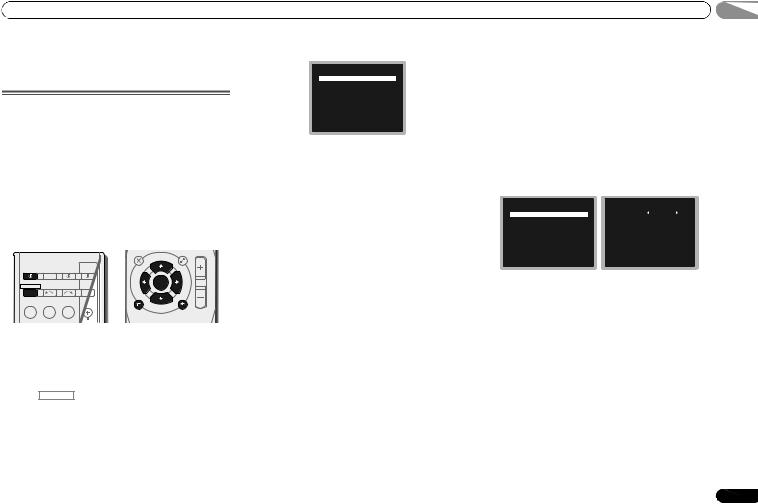
Home menu |
0505 |
Chapter 5:
Home menu
Using the Home menu
The following section shows you how to make detailed settings to specify how you’re using the receiver, and also explains how to fine-tune individual speaker system settings to your liking.
 Important
Important
•The OSD will not appear if you have connected using the HDMI output to your TV. Use composite connections for Home Menu.
•If headphones are connected to the receiver, disconnect them.
•You can’t use the Home Menu when the iPod/USB input is selected.
|
PARAMETER |
MENU VOLUME |
|
TOP |
TUNE |
|
MENU |
|
RECEIVER |
TV |
|
SLEEP SOURCE CONTROL |
|
|
|
|
T |
|
P |
|
|
|
E |
|
R |
|
|
|
S |
ENTER |
E |
|
|
|
E |
S |
|
RECEIVER |
INPUT SELECT |
R |
|
E |
|
|
P |
|
T |
||
|
|
|
INPUT |
|
|
BD |
DVD |
CD |
HOME |
|
|
MENU |
TUNE |
BAND |
|||
|
|
|
PTY |
|
|
|
|
|
iPod CTRL |
|
RETURN |
|
|
|
CH |
|
MUTE |
|
|
|
|
|
|
1Switch on the receiver and your TV.
Press RECEIVER to switch on.
2Switch the TV input to the input that connects this receiver to the TV through the corresponding composite cable.
3Press RECEIVER , then press HOME MENU.
The Home menu appears on your TV. Use / / / and ENTER on the remote control to navigate through the screens and select menu items. Press RETURN to exit the current menu.
• Press HOME MENU at any time to exit the Home menu.
4 Select the setting you want to adjust.
Home Menu
1.Manual SP Setup 2.Input Assign 3.Auto Power Down 4.HDMI Setup
Return
•Manual SP Setup
-Speaker Setting – Specify the size and number of speakers you’ve connected (see below).
-X.Over – Specify which frequencies will be sent to the subwoofer (page 28).
-Channel Level – Adjust the overall balance of your speaker system (page 28).
-Speaker Distance – Specify the distance of your speakers from the listening position (page 29).
•Input Assign – Specify what you’ve connected to the
ANALOG IN1 audio input (see The Input Assign menu on page 29).
•Auto Power Down – Sets to automatically turn off the power when the receiver has not operated for several hours (see The Auto Power Down menu on page 29).
•HDMI Setup – Set the audio return channel function and set the HDMI input signal to Standby Through output or not during standby (see The HDMI Setup menu on
page 30).
|
|
|
|
|
|
|
|
English |
|
Manual speaker setup |
|
|
|
|
|
|
|||
This receiver allows you to make detailed settings to optimize |
|
||||||||
|
|
||||||||
the surround sound performance. You only need to make |
|
|
|||||||
these settings once (unless you change the placement of |
|
|
|||||||
|
|
||||||||
your current speaker system or add new speakers). |
|
||||||||
Français |
|||||||||
|
|
|
|
|
|
|
|
||
Speaker Setting |
|
|
|
|
|
|
|||
|
|
|
|
|
|
|
|||
Use this setting to specify your speaker configuration (size, |
|
||||||||
number of speakers). |
|
|
|
|
|
|
|
||
menu. |
|
|
|
|
|
|
|
Español |
|
1 Select ‘Manual SP Setup’ from the Home Menu. |
|
||||||||
2 Select ‘Speaker Setting’ from the Manual SP Setup |
|
||||||||
|
|
|
|
|
|
|
|||
1.Manual SP |
Setup |
1a.Speaker |
Setting |
|
|||||
|
|
|
|
|
|
|
|||
a.Speaker |
Setting |
Front |
|
SMALL |
|
||||
b.X.Over |
|
Center |
[ |
SMALL ] |
|
||||
c.Channel |
Level |
Surr |
[ |
SMALL ] |
|
||||
d.Speaker |
Distance |
Subwoofer: |
YES |
|
|||||
Return |
Return |
3 Choose the set of speakers that you want to set then
select a speaker size.
Use / to select the size (and number) of each of the following speakers:
•Front –Select LARGE if your front speakers reproduce bass frequencies effectively, or if you didn’t connect a subwoofer. Select SMALL to send the bass frequencies to the subwoofer.
•Center – Select LARGE if your center speaker reproduces bass frequencies effectively, or select SMALL to send bass frequencies to the other speakers or subwoofer. If you didn’t connect a center speaker, choose NO (the center channel is sent to the other speakers).
•Surr – Select LARGE if your surround speakers reproduce bass frequencies effectively. Select SMALL to send bass frequencies to the other speakers or subwoofer. If you didn’t connect surround speakers choose NO (the sound of the surround channels is sent to the other speakers).
27
En
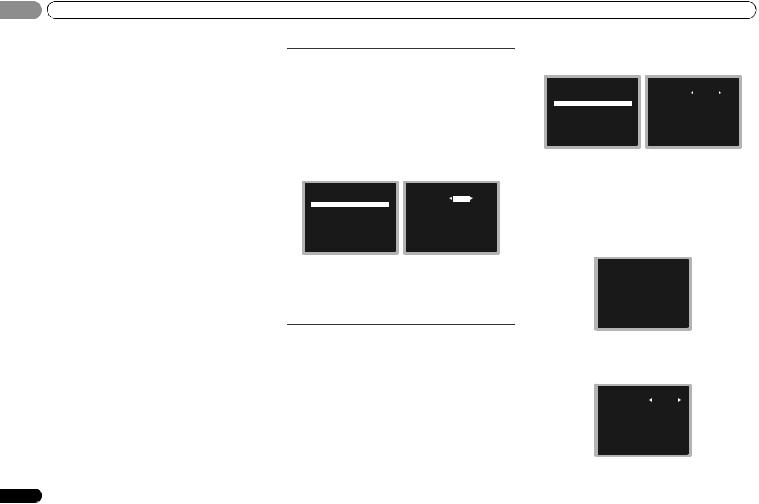
05Home menu
•Subwoofer – LFE signals and bass frequencies of channels set to SMALL are output from the subwoofer when YES is selected (see notes below). Choose the PLUS setting if you want the subwoofer to output bass sound continuously or you want deeper bass (the bass frequencies that would normally come out the front and center speakers are also routed to the subwoofer). If you did not connect a subwoofer choose NO (the bass frequencies are output from other speakers).
4 When you’re finished, press RETURN.
You return to the Manual SP Setup menu.
 Note
Note
•If you select SMALL for the front speakers, the subwoofer will automatically be fixed to YES. Also, the center, surround can’t be set to LARGE if the front speakers are set to SMALL. In this case, all bass frequencies are sent to the subwoofer.
•If you have a subwoofer and like lots of bass, it may seem logical to select LARGE for your front speakers and PLUS for the subwoofer. This may not, however, yield the best bass results. Depending on the speaker placement of your room you may actually experience a decrease in the amount of bass due to low frequency cancellations. In this case, try changing the position or direction of speakers. If you can’t get good results, listen to the bass response with it set to PLUS and YES or the front speakers set to LARGE and SMALL alternatively and let your ears judge which sounds best. If you’re having problems, the easiest option is to route all the bass sounds to the subwoofer by selecting SMALL for the front speakers.
X.Over
• Default setting: 200Hz
This setting decides the cutoff between bass sounds playing back from the speakers selected as LARGE, or the subwoofer, and bass sounds playing back from those selected as SMALL. It also decides where the cutoff will be for bass sounds in the LFE channel.
•For more on selecting the speaker sizes, see Speaker Setting above.
1Select ‘Manual SP Setup’ from the Home Menu.
2Select ‘X.Over’ from the Manual SP Setup menu.
1.Manual SP |
Setup |
1b.X.Over |
|
a.Speaker |
Setting |
Frequency |
100Hz |
b.X.Over |
|
|
|
c.Channel |
Level |
|
|
d.Speaker |
Distance |
|
|
|
Return |
|
Return |
3Choose the frequency cutoff point.
Frequencies below the cutoff point will be sent to the subwoofer (or LARGE speakers).
4When you’re finished, press RETURN.
You return to the Manual SP Setup menu.
Channel Level
Using the channel level settings, you can adjust the overall balance of your speaker system, an important factor when setting up a home theater system.
 CAUTION
CAUTION
•The test tones used in the Channel Level settings are output at high volume.
1Select ‘Manual SP Setup’ from the Home Menu.
2Select ‘Channel Level’ from the Manual SP Setup menu.
1.Manual SP |
Setup |
1c.Channel Level |
||
a.Speaker |
Setting |
Test Tone |
|
|
Manual |
||||
b.X.Over |
|
|
|
|
c.Channel |
Level |
|
|
|
d.Speaker |
Distance |
|
|
|
|
Return |
ENTER:Next |
Return |
|
3Select a setup option.
•Manual – Move the test tone manually from speaker to speaker and adjust individual channel levels.
•Auto – Adjust channel levels as the test tone moves from speaker to speaker automatically.
4Confirm your selected setup option.
The test tones will start after you press ENTER. After the volume increases to the reference level, test tones will be output.
1c.Channel Level
Test Tone |
[ Manual ] |
Please Wait . . .20
Caution Loud test tones
will be output.
Return
5 Adjust the level of each channel Using /.
If you selected Manual, use / to switch speakers. The Auto setup will outputs test tones in the order shown onscreen:
1c.Channel Level |
|
|
|
|
|
|
|
Front L |
|
0dB |
|
Center |
[ |
0dB] |
|
Front R |
[ |
0dB] |
|
Surround R |
[ |
0dB] |
|
Surround L |
[ |
0dB] |
|
Subwoofer |
[ |
0dB] |
|
|
|
Return |
|
28
En

Home menu |
0505 |
Adjust the level of each speaker as the test tone is emitted.
 Note
Note
•If you are using a Sound Pressure Level (SPL) meter, take the readings from your main listening position and adjust the level of each speaker to 75 dB SPL (C-weighting/slow reading).
•The subwoofer test tone is output at low volumes. You may need to adjust the level after testing with an actual soundtrack.
6 When you’re finished, press RETURN.
You return to the Manual SP Setup menu.
 Tip
Tip
• You can change the channel levels at any time by press RECEIVER , then press CH SELECT and LEV +/– on the
remote control. You can also press CH SELECT and use / to select the channel, and then use / to adjust the channel levels.
Speaker Distance
For good sound depth and separation from your system, you need to specify the distance of your speakers from the listening position. The receiver can then add the proper delay needed for effective surround sound.
•For the assignment of the digital signal inputs, see
Selecting the audio input signal on page 18.
1Select ‘Manual SP Setup’ from the Home Menu.
2Select ‘Speaker Distance’ from the Manual SP Setup menu.
1.Manual SP |
Setup |
1d.Speaker Distance |
|
|
|
|
a.Speaker |
Setting |
Front L |
|
10.0 |
ft |
|
b.X.Over |
|
Center |
[ |
10.0 |
ft |
] |
c.Channel |
Level |
Front R |
[ |
10.0 |
ft |
] |
d.Speaker |
Distance |
Surround R |
[ |
10.0 ft |
] |
|
|
|
Surround L |
[ |
10.0 |
ft |
] |
|
|
Subwoofer |
[ |
10.0 |
ft |
] |
|
Return |
|
|
Return |
|
|
3Adjust the distance of each speaker Using /.
You can adjust the distance of each speaker in 0.1 feet increments.
4When you’re finished, press RETURN.
You return to the Manual SP Setup menu.
The Input Assign menu
ANALOG IN1 audio input terminal is assigned to CD under factory settings, but this can be changed to TV input.
1 Select ‘Input Assign’ from the Home Menu.
Home Menu
1.Manual SP Setup 2.Input Assign 3.Auto Power Down 4.HDMI Setup
Return
2 Select ‘Analog Input’ from the Input Assign menu.
2.Input Assign |
2a.Analog |
Input |
a.Analog Input |
Analog |
CD |
Return |
|
Return |
3Select the desired input option for the ANALOG IN1 audio input terminal.
4When you’re finished, press RETURN.
You return to the Input Assign menu.
The Auto Power Down menu
Set to automatically turn off the receiver after a specified time has passed (when the power has been on with no operation for several hours).
• Default setting: OFF
1 Select ‘Auto Power Down’ from the Home Menu.
Home Menu
1.Manual SP Setup 2.Input Assign 3.Auto Power Down 4.HDMI Setup
Return
3.Auto Power Down
Auto Power Down  OFF
OFF
Return
2Specify the amount of time to allow before the power is turned off (when there has been no operation).
•You can select 2, 4 or 6 hours, or OFF (if no automatic shutoff is desired).
3When you’re finished, press RETURN.
You return to the Home menu.
 Important
Important
•If the Standby Through of the HDMI Setup is not set to
OFF, the Auto Power Down setting will automatically be set to OFF and cannot be changed.
Español Français English
29
En

05 Home menu
The HDMI Setup menu
If your TV supports an audio return channel (ARC) function, connect your TV and this unit with an HDMI cable and the TV audio will be inputted into this unit via the HDMI terminal without the need for an audio cable to be connected. It is possible to transfer signals from an HDMI connected player to the TV even when this receiver’s power is on standby.
 Important
Important
• Use a High Speed HDMI®/™ Cable when using the ARC function. The ARC function may not operate properly with other HDMI cables.
1 Select ‘HDMI Setup’ from the Home Menu.
Home Menu |
4.HDMI Setup |
|
|
|
1.Manual SP Setup |
ARC |
|
|
|
OFF |
||||
2.Input |
Assign |
Standby Through [ |
OFF |
] |
3.Auto |
Power Down |
|
|
|
4.HDMI |
Setup |
|
|
|
|
Return |
|
Return |
|
2 Choose the ‘ARC’ setting you want.
When a TV supporting the HDMI Audio Return Channel function is connected to the receiver, the sound of the TV can be input via the HDMI terminal.
•ON – The TV’s sound is input via the HDMI terminal.
•OFF – The TV’s sound is input from the audio input terminals other than HDMI inputs.
3 Choose the ‘Standby Through’ setting you want.
When the receiver is in standby, the HDMI input signal selected here will be output to the TV by HDMI.
•LAST – The HDMI input signal selected previously will be output.
•BD, DVD, SAT/CBL, GAME – The HDMI input signal selected here will be output.
•OFF – Signal will not be output during standby.
–If the Standby Through setting is not set to OFF, the power consumption during standby will increase.
The Auto Power Down setting will also be automatically set to OFF.
30
4 When you’re finished, press RETURN.
You return to the Home menu.
Before starting ARC operation
When starting ARC operation, put the TV and this unit in STANDBY mode after connecting this unit with the TV. Next, turn ON the power of this unit and then the TV, in this order. In order to start ARC operation, after connecting this unit to a TV with an HDMI cable, you will need to switch the input on the TV to the input mode required to connect to this unit. Then, you can select a TV program.
 Important
Important
•The ARC function may not operate even if the above conditions are met. If this is the case, listen to the TV audio after connecting this unit and the TV with an audio cable.
•The CEC (Consumer Electronic Control) function may activate when the ARC function is turned ON, causing power to turn ON and OFF and the input to switch from one to another. Since this unit does not guarantee synchronized operation based on the CEC function, we recommend that you turn OFF the HDMI CONTROL setting on the connected player. This unit may not operate properly if the HDMI CONTROL on the player is ON. Refer to the relevant device's instruction manual for details. If this does not work, turn OFF the ARC function. If this is the case, listen to the TV audio after connecting this unit and the TV with an audio cable. In addition, this unit does not guarantee synchronized operation that allows the TV remote control to operate the volume (including mute). Use this unit to operate the volume (including mute).
•Turn OFF the power and remove the power cord from the wall socket when connecting other devices or making connection changes to this unit. After all connections are completed, insert the power cord into the wall socket.
•If the power cord is connected when the ARC function is ON, the HDMI will take 2 to 10 seconds to initialize. This unit cannot be operated during the initialization. During initialization, the HDMI indicator on the display will blink. Turn ON the unit after blinking stops.
En
